Schneider Shorts of 24 May 2024 – an Australian dean helps a young man from Iran, two British professors discover Asian papermills, Nature opens a smoking lounge, German doctors suffer tragic retractions, a special issue pulled due to Swedish professor, and how Cell Press bends over backwards for an angry old German man.
Table of Discontent
Science Elites
- Impressed with his enthusiasm – How Sydney Dean Marcel Dinger helped a young man in need
- Cardiff Sewer – Robert Sewell and his russian and Pakistani friends
- No idea who you are – John F Kennedy abducted by Iranians!
Scholarly Publishing
- Nature Cigarettes – agriculture journal run by Big Tobacco shills
- Mistakes we made and didn’t make – Cell Press saves Südhof’s paper with dishonest correction
Retraction Watchdogging
- Lost confidence – SciReps shouldn’t have corrected fraud by Akhavan-Sigari and Sillanpää
- Unable to verify the accuracy of the originally listed authorship list – Luque and Bokov lose another paper
- A number of articles, including this one – Springer journal retracts entire special issue edited by Zhihan Lv
- Without appropriate attribution – Madry, Cucchiarini and Space Dentist lose the fight
Science Elites
Impressed with his enthusiasm
Meet Marcel Dinger, Professor of Genome Biology and Dean of Science at the University of Sydney in Australia.
An unusual co-author for the Iranian papermillers Mohamed Taheri and Soudeh Ghafouri-Fard, even if the latter is connected to the highest echelons of Iranian regime. Taheri is currently employed as PhD student by the German University of Jena, together with Ghafouri-Fard he publishes garbage reviews citing other papermill garbage and clinical studies which lack the proper ethics approval. You can read the full story here:
Look What the Cat Dragged In
Meet Mohammad Taheri, PhD, a humble PhD student in Jena, Germany, and his equally unremarkable Iranian associate Dr Soudeh Ghafouri-Fard.
Both Dinger’s institutional profile and his personal website list 15 joint papers with Taheri and Ghafouri-Fard, published between 2020 and 2022. At that time period, Dinger was Head of School of Biotechnology and Biomolecular Sciences at UNSW Sydney.
Some of these joint studies are on PubPeer now, thanks to Alexander Magazinov. Dinger is the only non-Iranian author. These reviews cite retracted papers, sometimes retracted prior to publication:
- Bashdar Mahmud Hussen , Hamed Shoorei , Mahdi Mohaqiq , Marcel E. Dinger, Hazha Jamal Hidayat , Mohammad Taheri , Soudeh Ghafouri-Fard The Impact of Non-coding RNAs in the Epithelial to Mesenchymal Transition Frontiers in Molecular Biosciences (2021) doi: 10.3389/fmolb.2021.665199
- Kaveh Ebahimzadeh , Hamed Shoorei , Seyed Ali Mousavinejad , Farhad Tondro Anamag , Marcel E. Dinger, Mohammad Taheri , Soudeh Ghafouri-Fard Emerging role of non-coding RNAs in response of cancer cells to radiotherapy Pathology – Research and Practice (2021) doi: 10.1016/j.prp.2020.153327
- Amin Safa , Mahdi Gholipour , Marcel E. Dinger, Mohammad Taheri, Soudeh Ghafouri-Fard The critical roles of lncRNAs in the pathogenesis of melanoma Experimental and Molecular Pathology (2020) doi: 10.1016/j.yexmp.2020.104558
- Mohammad Taheri , Hamed Shoorei , Farhad Tondro Anamag , Soudeh Ghafouri-Fard, Marcel E. Dinger LncRNAs and miRNAs participate in determination of sensitivity of cancer cells to cisplatin Experimental and Molecular Pathology (2021) doi: 10.1016/j.yexmp.2021.104602
- Mohammad Taheri , Bashdar Mahmud Hussen , Farhad Tondro Anamag , Hamed Shoorei , Marcel E. Dinger, Soudeh Ghafouri-Fard The role of miRNAs and lncRNAs in conferring resistance to doxorubicin Journal of Drug Targeting (2022) doi: 10.1080/1061186x.2021.1909052
Dinger is listed as corresponding author on the last two papers. In Taheri et al 2022, Magazinov counted 13 retracted references and then got bored.
I wrote to Dinger, and received a reply right away:
“By way of background, Mohamad Taheri got in touch with me about 4 years ago shortly after I started my role at UNSW. He had been in touch with me to pursue a PhD and appeared to have some track record in my area of research (noncoding RNA) so I was happy to entertain a conversation. I spoke to him a couple of times and was impressed with his enthusiasm. He seemed quite genuine in terms of his interest and knowledge in the field and had put together a research proposal etc. To improve his competitiveness for a PhD application, he was trying to improve his track record and he asked for my input on a couple of review papers he had been working on, which I was happy to do. He then involved me in some further review papers, which I similarly helped out with. I didn’t think much of it – it is not unusual for a student to seek to improve their track record to improve their competitiveness to get an international scholarship. […]
I had quite honestly not thought to check the integrity of the papers that had been cited in these review papers through this lens (to my knowledge, the papers had not been retracted at time of publication). […]
I will contact the editors of the relevant journals to see if an addendum or note can be added to highlight the papers that were cited but have since been retracted – or, if, appropriate (i.e. where any conclusions in the paper no longer hold) – recommend for the paper to be retracted entirely.“
So confusing. An Iranian applicant for a PhD position with hundreds of papers in his CV was rejected and told to “to improve his track record“? Dinger explained to me:
“International scholarships […] are extremely competitive and determined independently – a publication profile is just part of the story. Very strong candidates can still be turned away“
Maybe Taheri was turned away because the UNSW people noticed he was a fraud and a potential national security danger? Dinger then argued that there was a pandemic chaos that’s why he “was not provided with a reason why Mohamed’s scholarship application was not successful“. In any case, he immediately started publishing reviews with Taheri – the first one was submitted in May 2020, just after the PhD interview.
Kostya Ostrikov’s russo-iranian false friends
“Let me assure you that I totally condemn the war in Ukraine, and at the very least because my old mother is in Kharkiv and she suffers a lot… I am trying to help my colleagues and friends from Ukraine whichever way I can…” – Professor Kostya “Ken” Ostrikov
Dinger also told me about his noncoding RNA database project, which he said “requires considerable manual curation and this is what Mohamed had been working on”. But Taheri is not author on Dinger’s database papers which he sent me, instead Dinger is author on Taheri’s papermill trash!
This clinical study by Dinger and Ghafouri-Fard (but without Taheri as author) was published in a journal where the PhD student Taheri is editorial board member sporting a PhD degree. It is obvious Taheri acted as editor:
Soudeh Ghafouri-Fard , Bahdar Mahmud Hussen , Sara Pashmforoush , Mohammad Taghi Akbari , Shahram Arsang-Jang , Naghme Nazer , Amir Ali Hamidieh , Abbas Hajifathali , Marcel E. Dinger, Arezou Sayad, Mohammadreza Ostadali Dehaghi HLA alleles and haplotype frequencies in Iranian population Human Antibodies (2022) doi: 10.3233/hab-220004

Dinger’s comment was to confirm the suspicion:
“This paper was originally submitted to Genomics and Mohamed was an author on this submission. It was rejected from this journal.
It’s publication in Human Antibody occurred without my consent.”
Then all is well, right?
Dinger just has no luck with people who invite him as coauthor. In the next case, he collaborated with the Italian professor Giovanni Perini, who has two retractions, several highly inappropriate corrections and a list of fake papers on PubPeer.
Pei Y. Liu , Andrew E. Tee , Giorgio Milazzo , Katherine M. Hannan , Jesper Maag , Sujanna Mondal , Bernard Atmadibrata , Nenad Bartonicek , Hui Peng , Nicholas Ho , Chelsea Mayoh , Roberto Ciaccio , Yuting Sun , Michelle J. Henderson , Jixuan Gao , Celine Everaert , Amy J. Hulme , Matthew Wong , Qing Lan , Belamy B. Cheung , Leming Shi, Jenny Y. Wang, Thorsten Simon, Matthias Fischer, Xu D. Zhang, Glenn M. Marshall, Murray D. Norris, Michelle Haber, Jo Vandesompele, Jinyan Li, Pieter Mestdagh, Ross D. Hannan, Marcel E. Dinger, Giovanni Perini, Tao Liu The long noncoding RNA lncNB1 promotes tumorigenesis by interacting with ribosomal protein RPL35 Nature Communications (2019) doi: 10.1038/s41467-019-12971-3
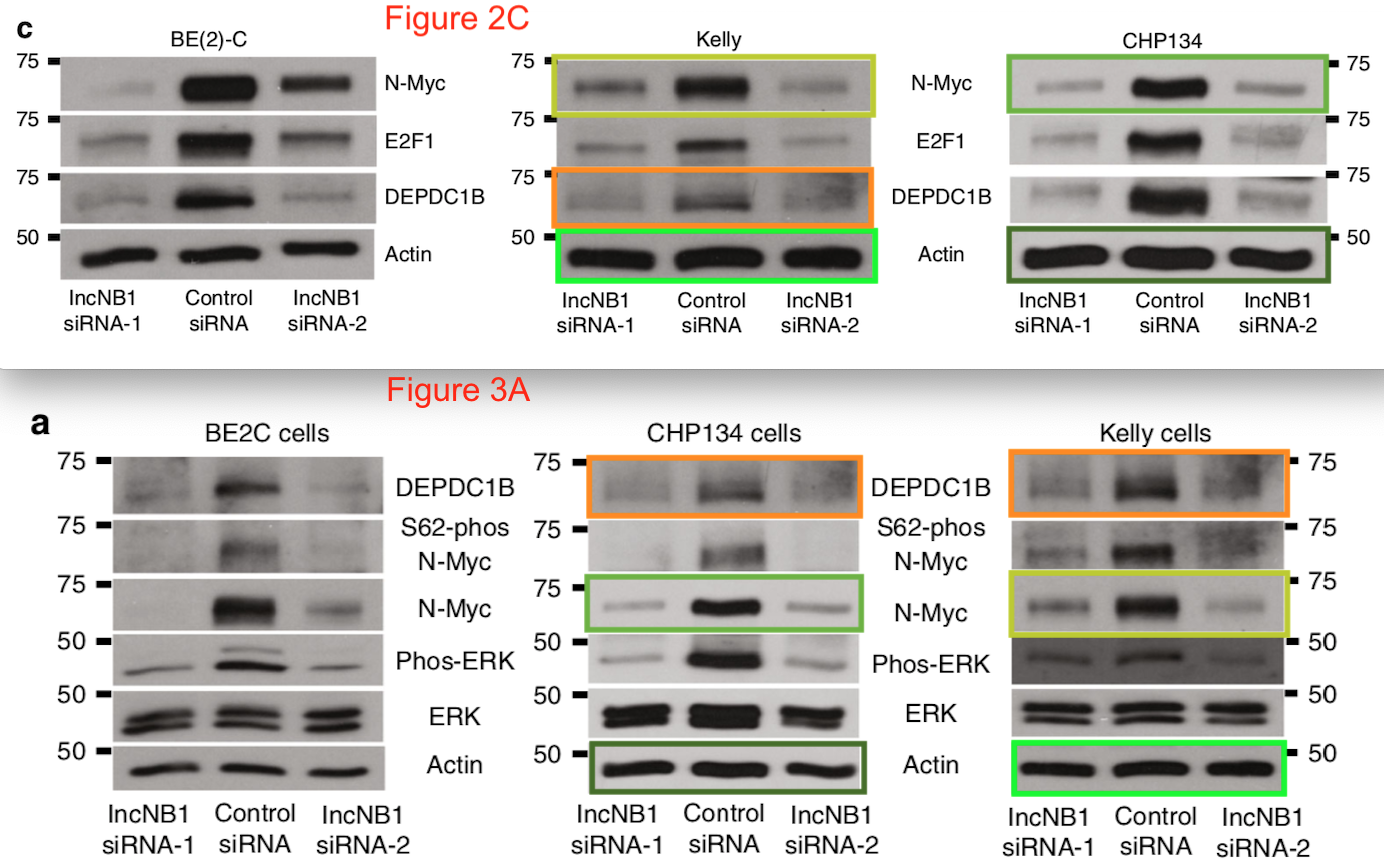
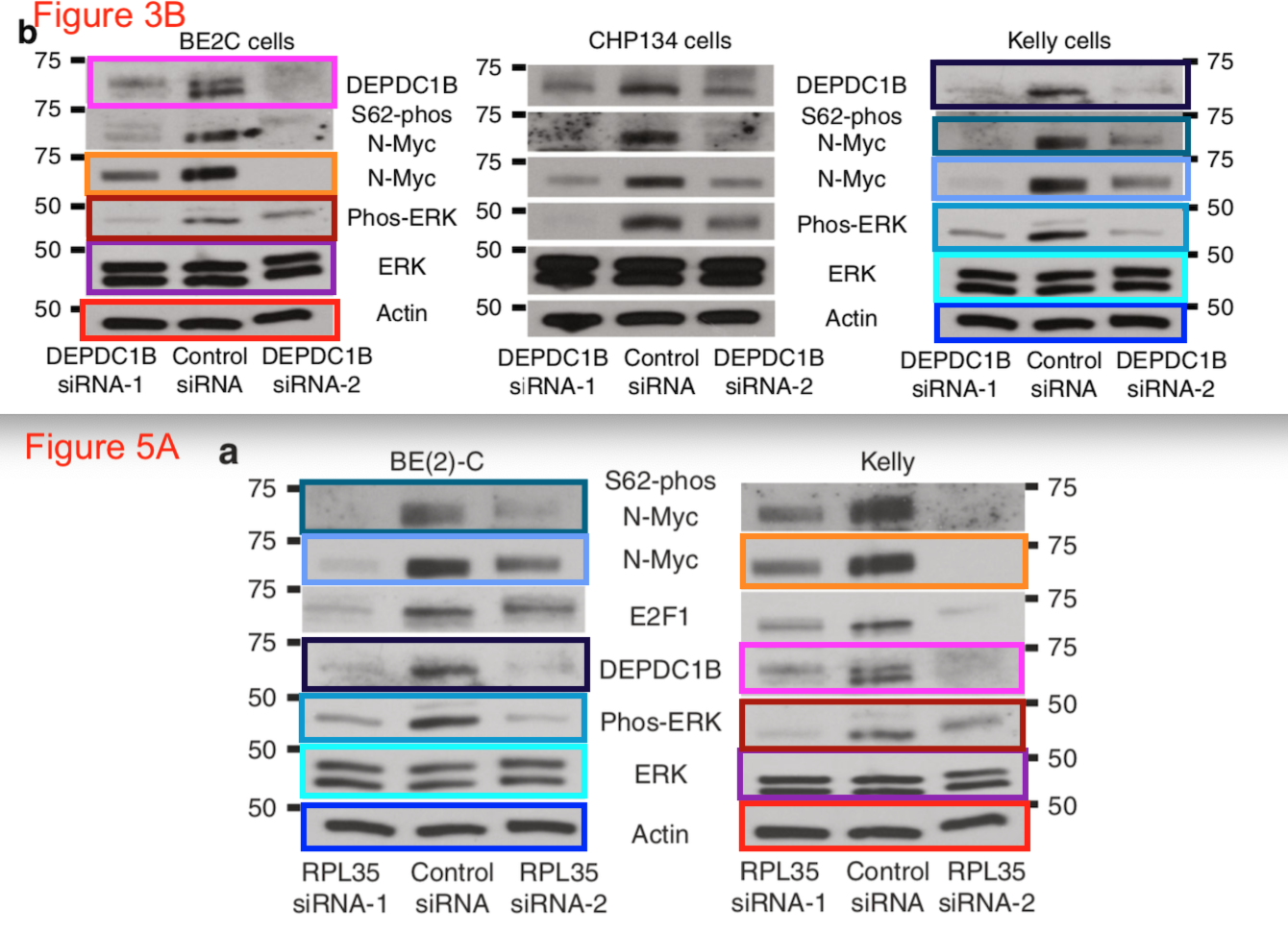
Boxes in different shades of blue highlight panels that represent Kelly cells with DEPDC siRNAs in Figure 3B and BE(2)C cells with RPL35 siRNAs in Figure 5A.
Boxes in different shades of red/orange/pink highlight panels that represent BE2C cells with DEPDC siRNAs in Figure 3B and Kelly cells with RPL35 siRNAs in Figure 5A.”
In November 2019, Dinger’s collaborator at UNSW, Tao Liu, admitted that he and his team “accidently made mistakes […] when we prepared the first revision of the manuscript” and announced to “have e-mailed the editor of the journal to make the correction.” That was obviously meant ironically, not even a correction was published since.
Cardiff Sewer
Meet Robert Sewell, honorary professor at the at the School of Pharmacy and Pharmaceutical Sciences at Cardiff University in UK since 1976. I wrote about this university before, for example it turned out to be quasi-owned by the Chinese TCM industry. That’s what their TCM professor Wen G Jiang is free to publish any fake science and will forever remain innocent.
Fried Divine Comedy, featuring anti-cancer cockroach and phallic fungus
This is a follow-up to the previous article, about a misconduct investigation at the Cardiff University in UK into the published works of cancer researcher Wen Jiang, professor of Surgery and Tumour Biology, Fellow of Royal Society of Medicine and chair of Cardiff China Medical Research Collaborative. The following guest post by my regular contributor Smut…
There is little information about Sewell online. In 2012, his university awarded him as Teacher of the Year. There is an immunology professor named Andrew Sewell in Cardiff, maybe a brother? In any case, Robert Sewell and some russian and Pakistani fraudsters found each other to bring furtehr glory to that Welsh university.
Mu Yang aka “Dysdera arabisenen” studied these recent publications, the result is on PubPeer. Like this triptych, where same figure was reused with some change in formatting:
- Marina A Gruden , Tatiana V Davidova , Kiran Yanamandra , Valery G Kucheryanu , Ludmilla A Morozova-Roche , Vladimir V Sherstnev , Robert D E Sewell Nasal inoculation with α-synuclein aggregates evokes rigidity, locomotor deficits and immunity to such misfolded species as well as dopamine Behavioural Brain Research (2013) doi: 10.1016/j.bbr.2013.01.011
- Marina A. Gruden , Robert D.E. Sewell , Kiran Yanamandra , Tatyana V. Davidova , Valery G. Kucheryanu , Evgeny V. Bocharov , Olga A. Bocharova , Vsevolod V. Polyschuk , Vladimir V. Sherstnev , Ludmilla A. Morozova-Roche Immunoprotection against toxic biomarkers is retained during Parkinson’s disease progression Journal of Neuroimmunology (2011) doi: 10.1016/j.jneuroim.2010.12.001
- Marina A Gruden , Kiran Yanamandra , Valery G Kucheryanu , Olga R Bocharova , Vladimir V Sherstnev , Ludmilla A Morozova-Roche , Robert D E Sewell Correlation between protective immunity to α-synuclein aggregates, oxidative stress and inflammation Neuroimmunomodulation (2012) doi: 10.1159/000341400
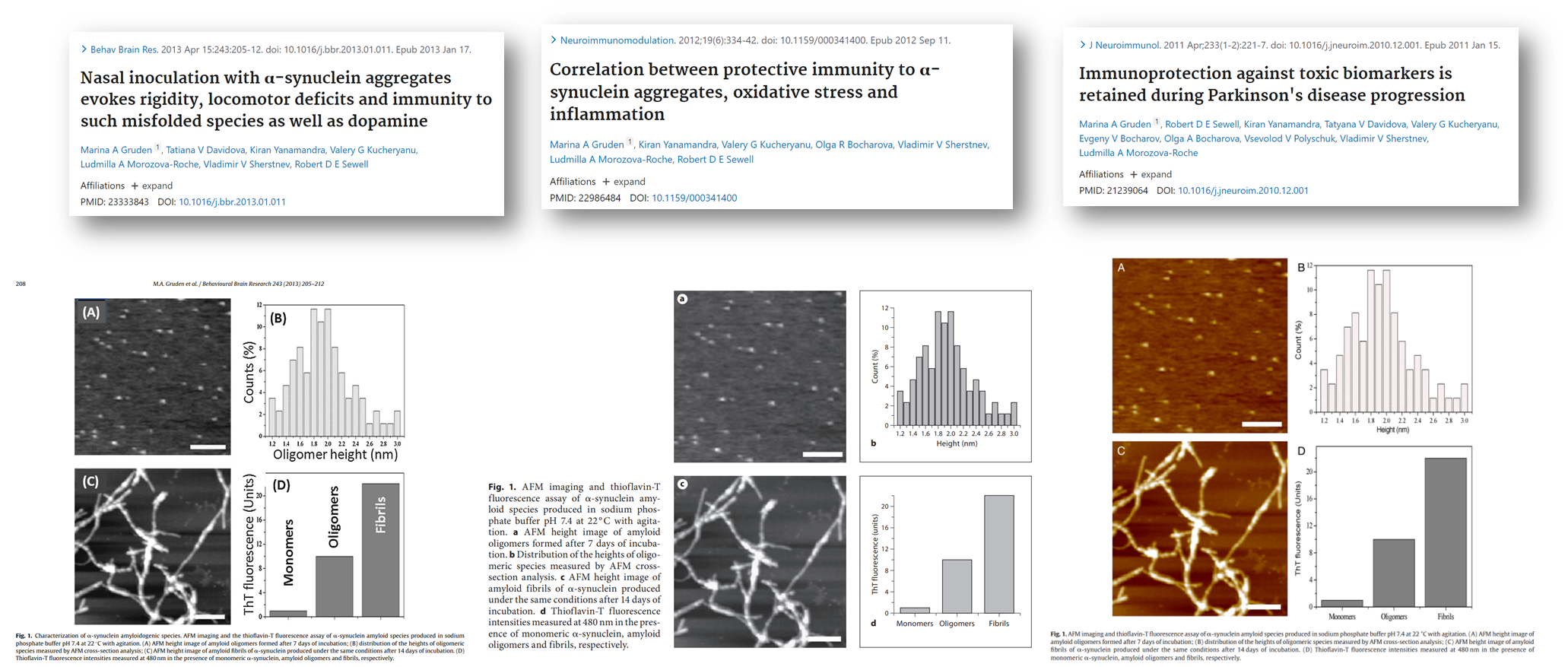
There are other russian papers by Sewell, where it becomes clear from repetitive numbers in the tables that the experimental data was made up. For example:
Marina A Gruden , Tatiana V Davydova , Victor B Narkevich , Valentina G Fomina , Chao Wang , Vladimir S Kudrin , Ludmilla A Morozova-Roche , Robert D E Sewell Intranasal administration of alpha-synuclein aggregates: a Parkinson’s disease model with behavioral and neurochemical correlates Behavioural Brain Research (2014) doi: 10.1016/j.bbr.2014.01.017
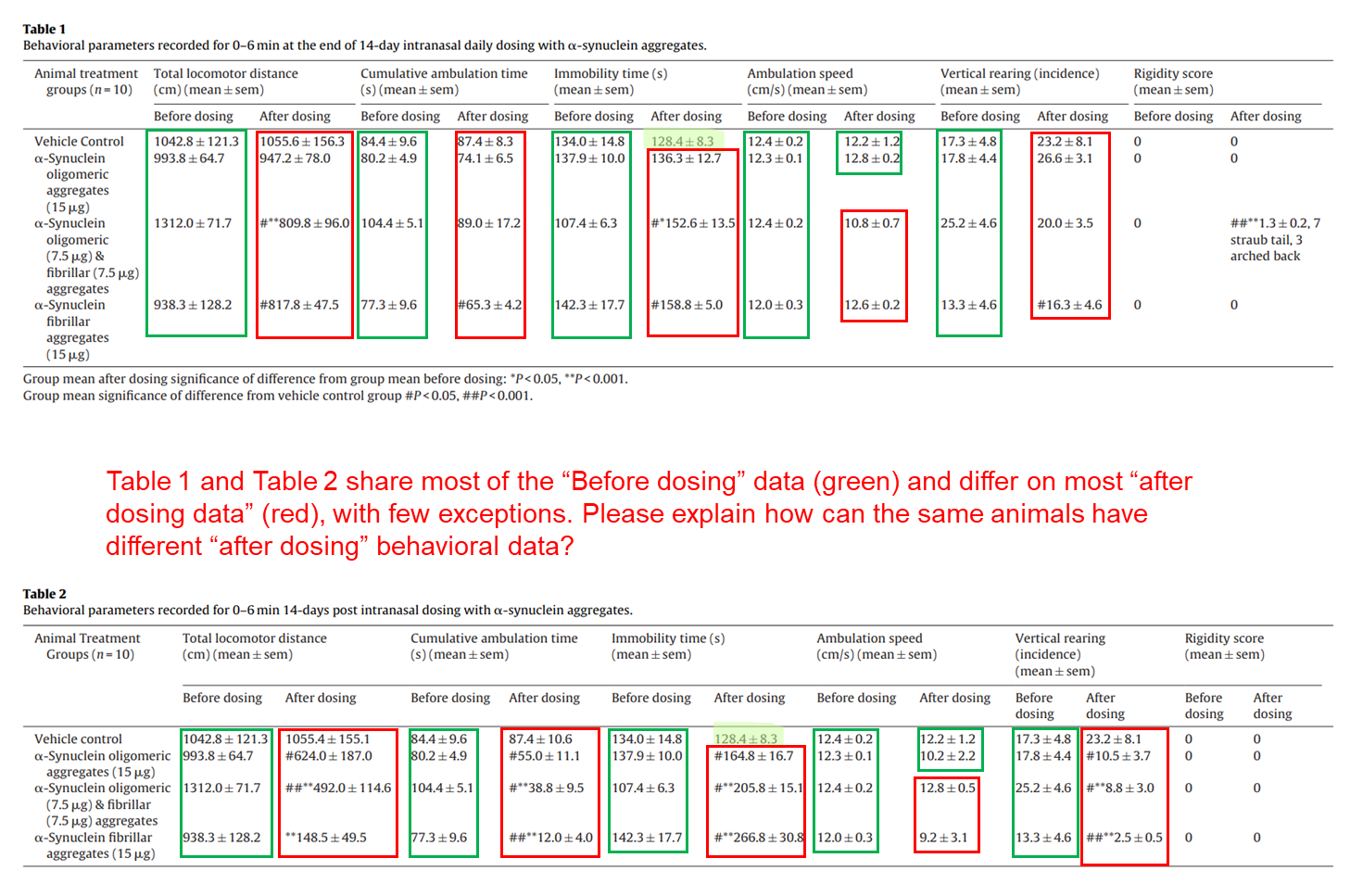
Years later, Sewell’s Pakistani papers also show repetitive numbers! Like this one:
Dawood Shah , Arshad Iqbal , Fahad S Alshehri , Aman Ullah , Gowhar Ali , Tahir Muhammad , Rahim Ullah , Robert D E Sewell , Yusuf S Althobaiti The Neuroprotective Propensity of Organic Extracts of Acacia stenophylla Bark and Their Effectiveness Against Scopolamine-/Diazepam-Induced Amnesia in Mice Journal of Inflammation Research (2022) doi: 10.2147/jir.s376242
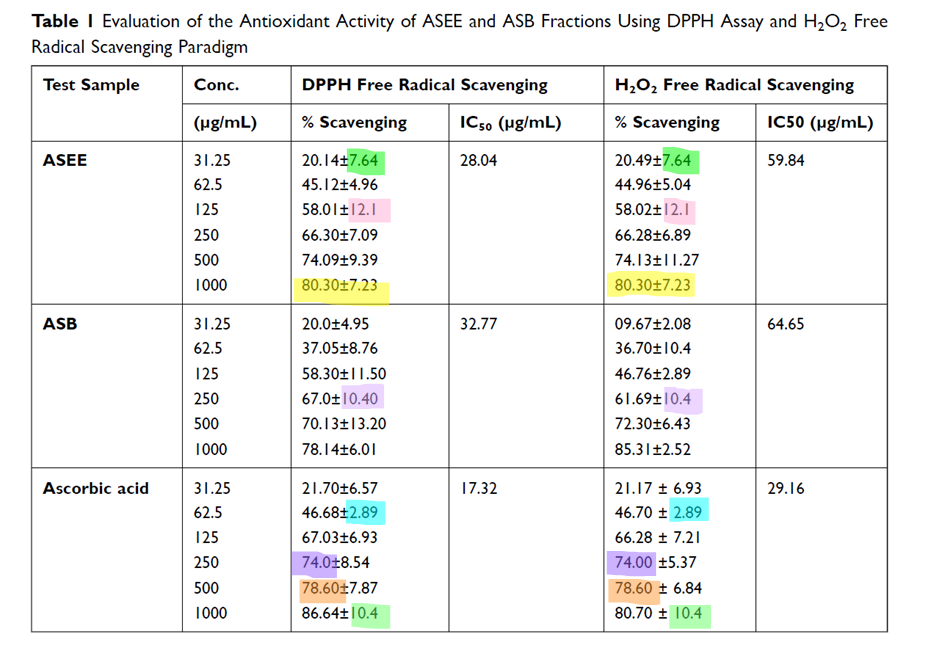
Or this:
Sonia Qureshi , Gowhar Ali , Muhammad Idrees , Tahir Muhammad , Il-Keun Kong , Muzaffar Abbas , Muhammad Ishaq Ali Shah , Sajjad Ahmad , Robert D E Sewell , Sami Ullah Selected Thiadiazine-Thione Derivatives Attenuate Neuroinflammation in Chronic Constriction Injury Induced Neuropathy Frontiers in Molecular Neuroscience (2021) doi: 10.3389/fnmol.2021.728128
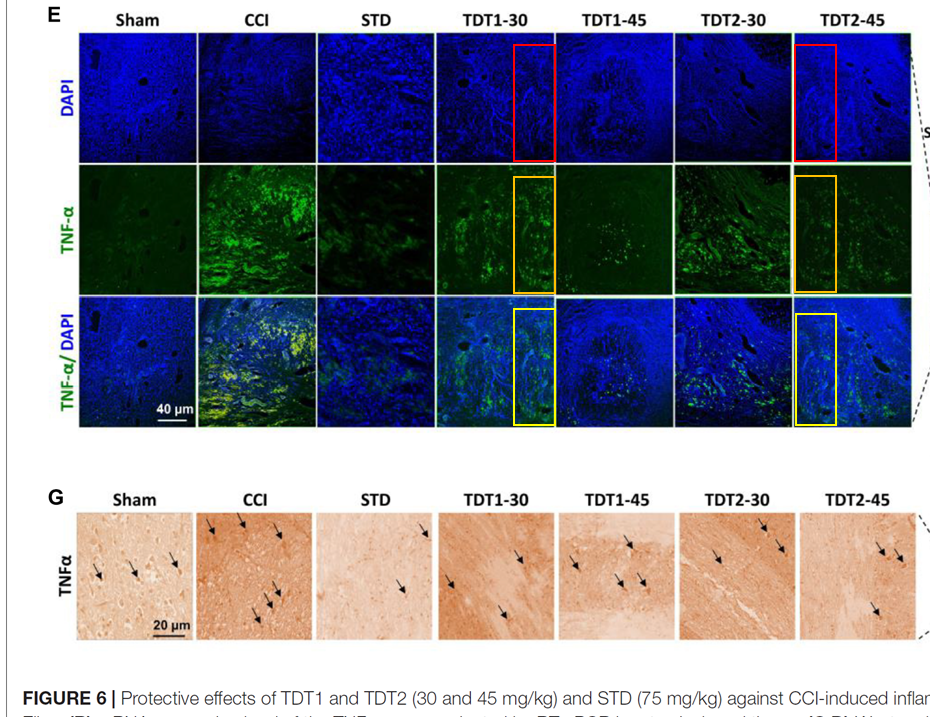
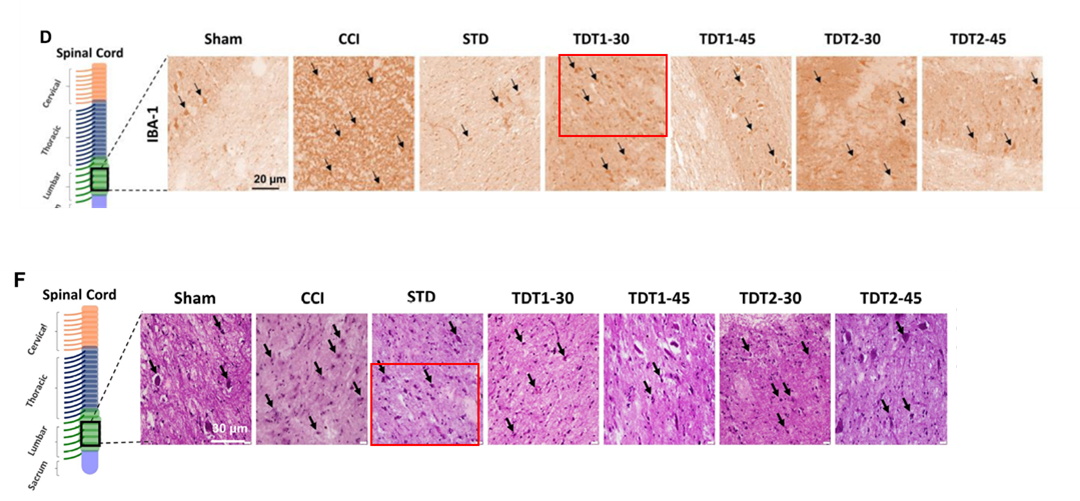
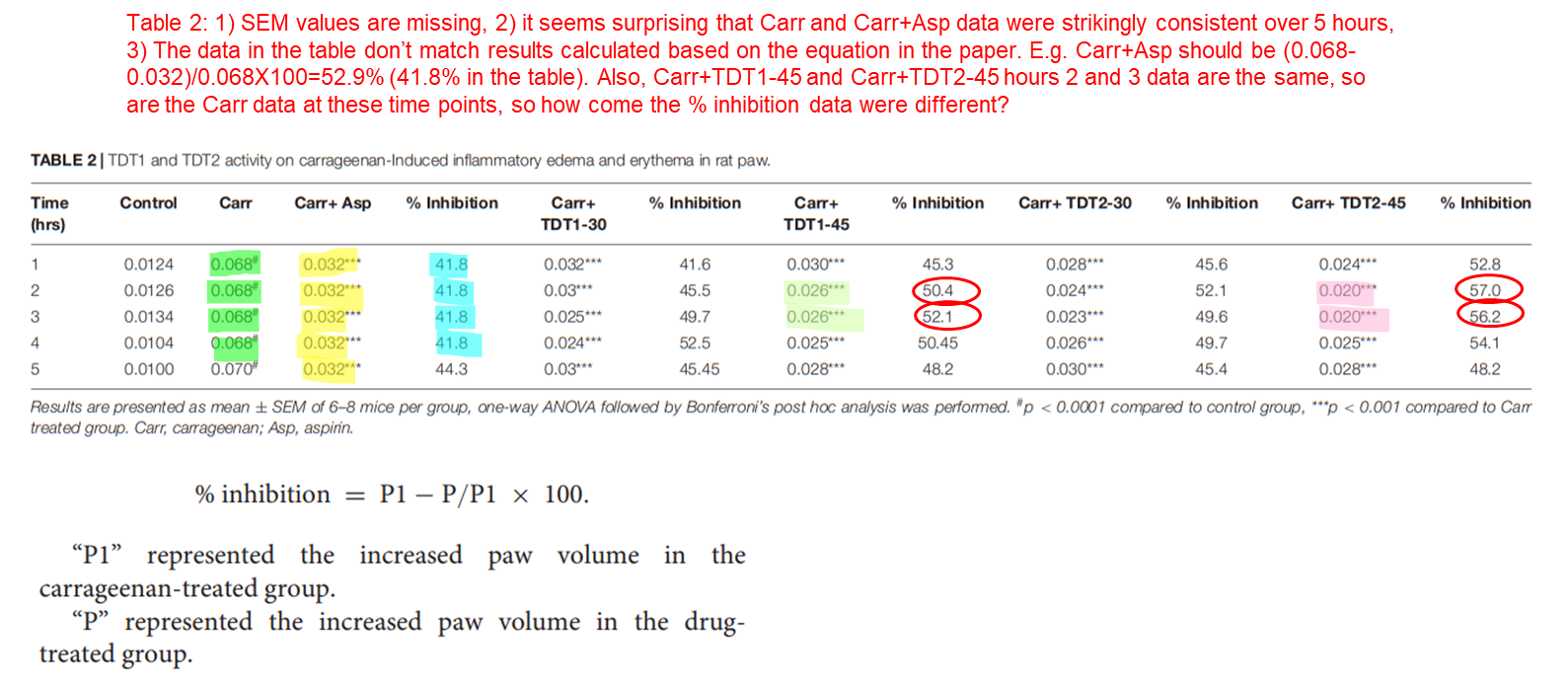
This was recently triumphantly corrected by Elsevier:
Jawad Khan, Gowhar Ali, Asma Khurshid, Aamer Saeed, Sajjad Ahmad, Najeeb Ullah, Ashrafullah Khan, Robert D Sewell, Muhammad Zakria Mechanistic efficacy assessment of selected novel methanimine derivatives against vincristine induced Neuropathy: In-vivo, Ex-vivo and In-silico correlates International Immunopharmacology (2022) doi: 10.1016/j.intimp.2022.109246
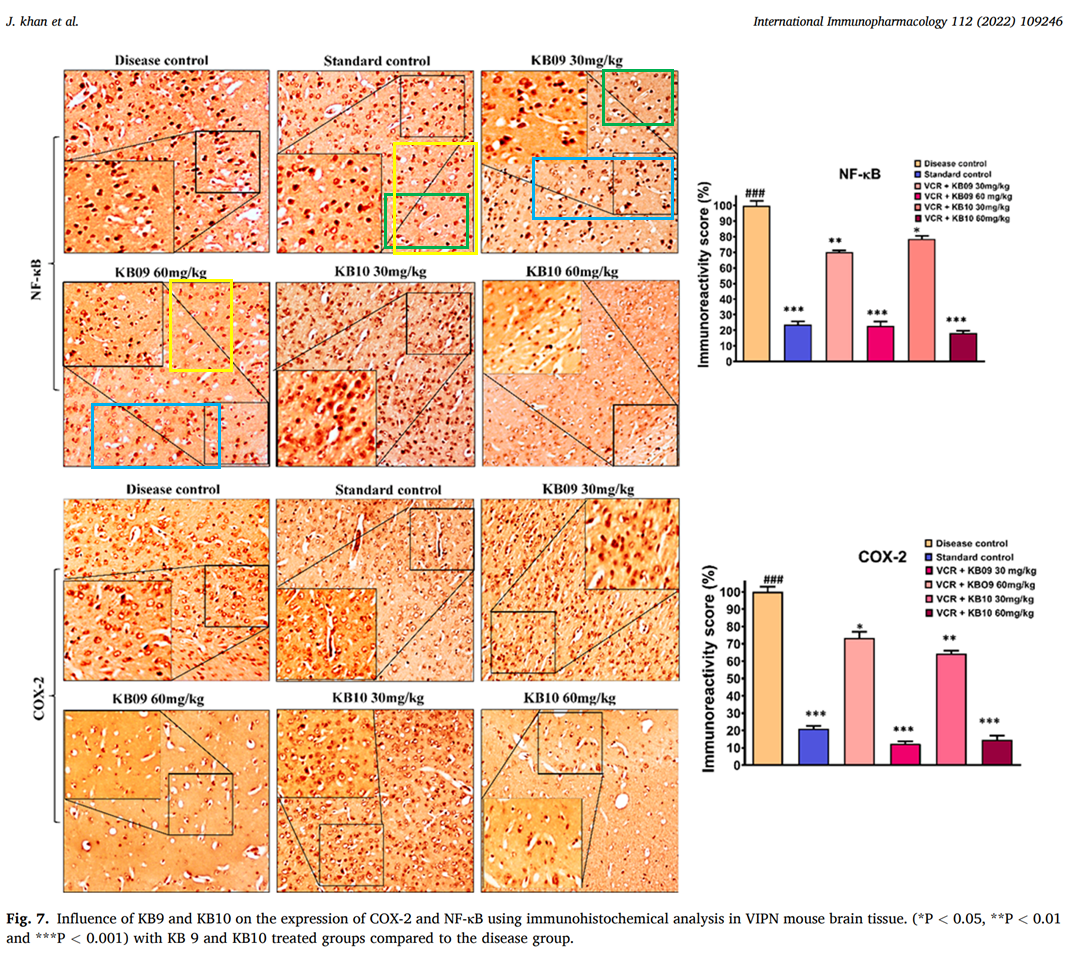
The Corrigendum from 10 March 2024 went:
“The authors regret for the error and thankful to the Editor/Journal for providing an opportunity to correct the Figure 7. Furthermore, the author apologises for the mistake and will exercise great care to avoid any mistake in the future.”
What did you expect from Elsevier, really. Sewell did not reply to my email.
No idea who you are
Meet John F Kennedy. Not the dead US president, but an 82 year old carbohydrate and protein chemistry researcher, formerly professor somewhere in UK, now owner of a small and possibly defunct biotech company called Chembiotech. He still calls himself professor, specifically “Prof. John F. Kennedy BA, BSc, PhD, DSc, EurChem CChem FRSC, EurProBiol CBiol FSB, CEng FIMC, CEnv FCIWEM, CSci FIFST, CText FTI, FCMI“.
A few years ago, Kennedy discovered Asian papermills, specifically Iranian ones, as his PubPeer record testifies. Courtesy of Alexander Magazinov, who found out that Kennedy’s Iranian papers are coauthored by and simultaneously excessively cite some Roohallah Saberi Riseh and some Mohadeseh Hassanisaadi. Utterly coincidentally, these papers were published in two Elsevier journals, Carbohydrate Polymers and International Journal of Biological Macromolecules where Kennedy acts as Editor-in-Chief. Here one example:
Mohadeseh Hassanisaadi , John F. Kennedy , Ali Rabiei , Roohallah Saberi Riseh, Abdolhossein Taheri Nature’s coatings: Sodium alginate as a novel coating in safeguarding plants from frost damages International Journal of Biological Macromolecules (2024) doi: 10.1016/j.ijbiomac.2024.131203
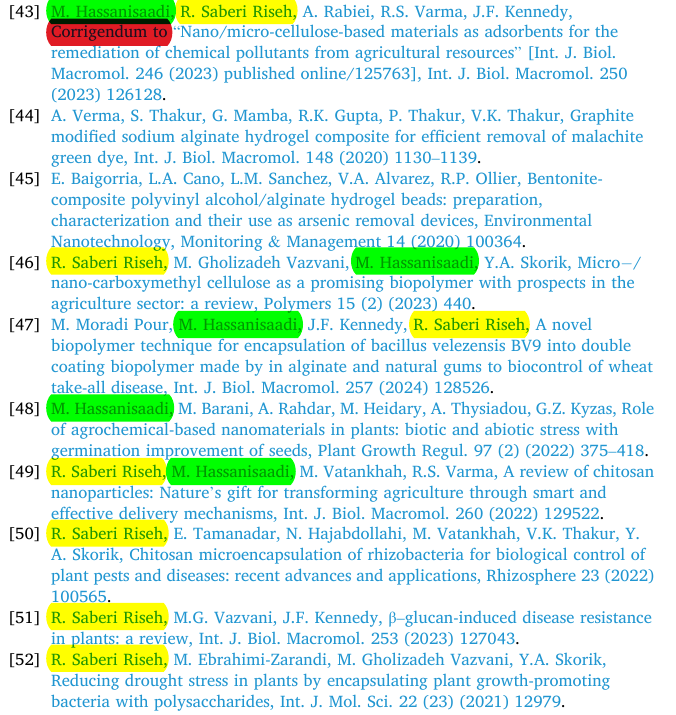
In fact, Kennedy was seen papermilling with some much bigger fishes before, caught by Elisabeth Bik. Published in a papermill-infested Elsevier journal and “written by authors from 17 different affiliations in Italy, United Arab Emirates, Algeria, Qatar, United Kingdom, Turkey, Saudi Arabia, Romania, Malaysia, Nigeria, Ecuador, and Hong Kong“:
Anna Maria Posadino , Roberta Giordo , Iman Ramli , Hatem Zayed , Gheyath K. Nasrallah , Zena Wehbe , Ali H. Eid , Eda Sönmez Gürer , John F. Kennedy , Afaf Ahmed Aldahish , Daniela Calina , Ahmad Faizal Abdull Razis, Babagana Modu , Solomon Habtemariam , Javad Sharifi-Rad, Gianfranco Pintus, William C. Cho An updated overview of cyanidins for chemoprevention and cancer therapy Biomedicine & Pharmacotherapy (2023) doi: 10.1016/j.biopha.2023.114783
There, Kennedy joined the pros of papermilling and citation-stacking – Daniela Calina, Javad Sharifi-Rad, William C. Cho – read about them here:
I have almost 100 manpower with me at any time
“WE DONT PAY FOR PAPERS. YOU MUST KNOW THAT THESE BEST IN THE PLANET JOURNALS GO THROUGH RIGOROUS PEER REVIEW” – Abhijit Dey, papermiller
One could think, maybe Kennedy is senile, or even dead, and his identity was stolen? After all, he initially didn’t reply to my email, but after I wrote to him, he commented on PubPeer, on this paper flagged by Magazinov for containing “many self-citations to a certain R Saberi Riseh“:
Roohallah Saberi Riseh, Mohadeseh Hassanisaadi , Masoumeh Vatankhah , John F Kennedy Encapsulating biocontrol bacteria with starch as a safe and edible biopolymer to alleviate plant diseases: A review Carbohydrate Polymers (2023) doi: 10.1016/j.carbpol.2022.120384
Kennedy wrote on PubPeer:
“I agree that unnecessary self citation is inappropriate and I have therefore taken this up with dr Riseh for explanation of relevance to the paper.”
And a few days later, Kennedy also wrote back to me to protest against my Iranian papermill accusations:
“I have no idea who you are – what evidence are you using to
come to your conclusions please?
Yours sincerely,
J.F.Kennedy”
I must prove that I am a real person to someone called John F Kennedy?
Scholarly Publishing
Nature Cigarettes
Nature opened a new portfolio journal. So far so boring.
But the agriculture journal npj Science of Plants is led by very interesting Editor-in-Chief and Associate Editor.
First, the EiC Yongfeng Guo, professor at the Tobacco Research Institute (TRI) of the Chinese Academy of Agricultural Sciences in Qingdao, China, is apparently a tobacco industry shill.
Guo and his institute have been receiving funding from the China National Tobacco Company (CNTC). According to Wikipedia, this company is “a national key state-owned corporation with monopoly status in China to manufacture and sell tobacco products.” The full name of Guo’s institute is actually ‘Qingzhou Tobacco Research Institute (QTRI) of CNTC’.

This 2011 paper by Gan & Glantz, titled “Relationship between the Chinese tobacco industry and academic institutions in China“, confirms:
“The Chinese Academy of Agricultural Sciences (CAAS), the highest level public agricultural research institute in China, established its tobacco research institute in 1958 in Qingzhou. In 1987, CNTC and CAAS began to co-administer this institute and added another name ‘Qingzhou Tobacco Research Institute (QTRI) of CNTC’ to its official title.”
Guo appears to be active at CORESTA (Cooperation Centre for Scientific Research Relative to Tobacco) – a tobacco industry lobby organisation registered in France, which “organises yearly meetings in which scientific papers are presented, along with reports and the results of studies and surveys” and where “Every major worldwide tobacco company and tobacco industry affiliated organisation is a member.” A Google search reveals multiple direct involvements of Guo with CORESTA, as meeting or workshop coordinator.
Here is such a book chapter from a CORESTA meeting, where Guo is first and corresponding author:
Guo et al, “Chapter 5 – Molecular regulation and genetic manipulation of alkaloid accumulation in tobacco plants” Studies in Natural Products Chemistry (2021) doi: 10.1016/B978-0-12-819489-8.00006-5.
“Prospects for developing tobacco cultivars with ultralow alkaloid levels to meet future potential regulation of combustible cigarette nicotine content are discussed.”
Guo’s coauthors are affiliated with British American Tobacco, Imperial Tobacco, Japan Tobacco International, and Altria Client Services LLC. You may wonder what that last business is, but Altria used to call itself Philip Morris.
Also, look at this paper by Guo, totally surprising to see that tobacco shills have to fudge data:
Xiaoxu Li , Cun Guo , Qi Wang , Zhiyuan Li , Jun Cai , Dousheng Wu , Yangyang Li , Aiguo Yang , Yongfeng Guo , Junping Gao , Liuying Wen , Wenxuan Pu Systematic Analysis of Tobacco CrRLK1L Family Genes and Functional Identification of NtCrRLK1L47 in Environmental Stresses Frontiers in Plant Science (2022) doi: 10.3389/fpls.2022.838857
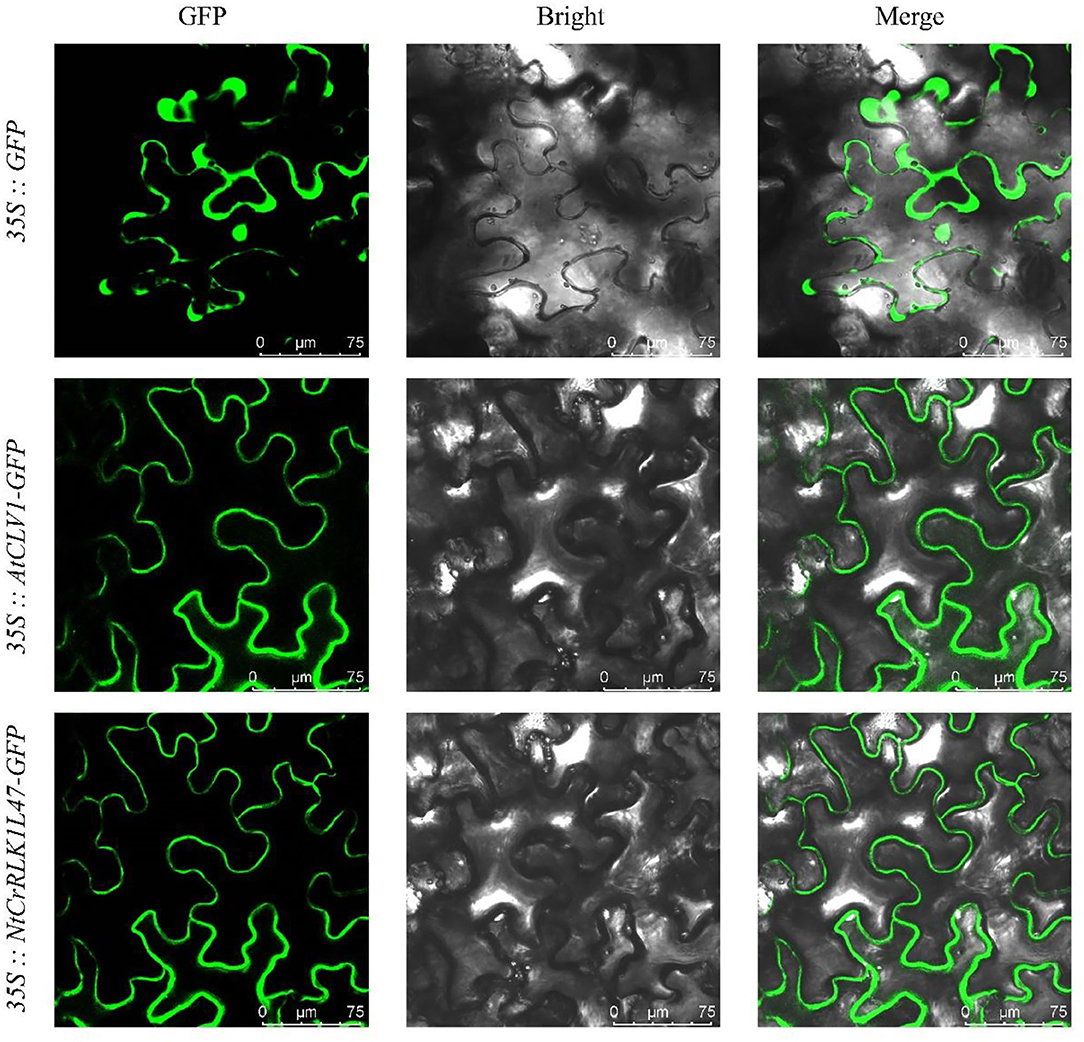
Griveaudia vieui: “In figure 8 the images supposed to represent 35::AtCLV1-GFP, and 35::NtCrRLK1L47-GFP are the same plants. Compare 2nd and 3rd rows”
The paper declares funding from “China Tobacco Hunan Industrial Co., Ltd. Technology Project (KY2021YC0001)“, a company which produces and sells cigarettes and chewing tobacco. As Conflict of Interest is stated that “XL, JG, and WP were employed by China Tobacco Hunan Industrial Co., Ltd.” It is by far not the only paper of Guo’s of this kind.
The Cigarette Mob of Palermo
On the gate of Constantinople was written, in a steel plate, the order of the Sultan: “All the males of the Gjomarkaj, generation after generation, from the cradle to the grave, will carry the title of Kapidan”
Now, to the Associate Editor Michael Timko, professor at the University of Virginia in USA. He has a long history of direct funding from Philip Morris / Altria ranging from at least 1999.
Riechers, D.E., Timko, M.P. Structure and expression of the gene family encoding putrescine N-methyltransferase in Nicotiana tabacum: new clues to the evolutionary origin of cultivated tobacco. Plant Mol Biol (1999). doi: 10.1023/A:1006342018991
“This work was supported by a grant from Philip Morris, Inc. (Richmond, VA) awarded to M.P.T.”
And ever since and until the recent one, in MDPI, where the authors advocate for “development of tobacco-based products with improved aroma and flavor”:
Rabara, R.C.; Kudithipudi, C.; Timko, M.P. Identification of Terpene-Related Biosynthetic Gene Clusters in Tobacco through Computational-Based Genomic, Transcriptomic, and Metabolic Analyses. Agronomy (2023) doi: 10.3390/agronomy13061632
“This work was supported by sponsored research project GI15099 awarded to MPT. The funding sponsors (Altria Client Services) had no role in the design of the study, collection, analyses, or interpretation of data, writing of the manuscript; or in the decision to publish the results”.
Timko also gets funding from the 22nd Century Group, a company selling reduced nicotine tobacco products. It is led by former Big Tobacco execs: President John Miller (formerly of Swisher international cigars), Vice-President Juan Sanchez Tamburrino – Vice President (formerly of British American Tobacco) and Director
Richard M Sanders (also President of Santa Fe Natural Tobacco Company).
In 2021, 22nd century group obtained FDA approval for low nicotine cigarettes, against the advice of public health experts.
Liu, H.; Kotova, T.I.; Timko, M.P. Increased Leaf Nicotine Content by Targeting Transcription Factor Gene Expression in Commercial Flue-Cured Tobacco (Nicotiana tabacum L.). Genes (2019) doi: 10.3390/genes10110930
“This work was supported by a grant from the 22nd Century Group, Inc (Williamsville, NY) awarded to M.P.T.”
Like Guo, Timko also appears to be a regular at CORESTA, here two of his coauthors are affiliated with Altria:
Rabara R.C.; Liu Hai; Kudithipudi C.; Timko M.P. Computational-based genomic, transcriptomic, and metabolic analyses of biosynthetic gene clusters in tobacco CORESTA Meeting, Agronomy/Phytopathology, 2023, Cancun, AP 21
With Guo and Timko in charge, this Nature journal will be likely lobbying for the tobacco industry. Rather shameful in 2023, but the money is good I guess.
A cherry on the cake is the another Associate Editor Salma Balazadeh, associate professor at Leiden University in the Netherlands, who insists that none of her published data is manipulated! Read here:
The Man Who Fed The World
“Bernd Müller-Röber […] had guest status in the MPI for Molecular Plant Physiology but this status has been terminated”
Mistakes we made and didn’t make
A very predictable thing happened. Cell Press terminated with a dishonest correction the investigation of a clearly manipulated paper by the Nobelist and Stanford professor Thomas Südhof.
Tom Südhof’s Verfolgte Unschuld
“The professional bloggers are now trying to turn this into a question of research integrity which is deeply misleading, and claim that they are doing this not for financial gain. Judge for yourself!” – Thomas Südhof, Nobel Prize laureate
This is the paper, read the background about Südhof’s questionable attitude and the problems uncovered by Maarten van Kampen in May 2024 Shorts:
Lulu Y. Chen, Man Jiang, Bo Zhang, Ozgun Gokce, Thomas C. Südhof Conditional Deletion of All Neurexins Defines Diversity of Essential Synaptic Organizer Functions for Neurexins Neuron (2017) doi: 10.1016/j.neuron.2017.04.011
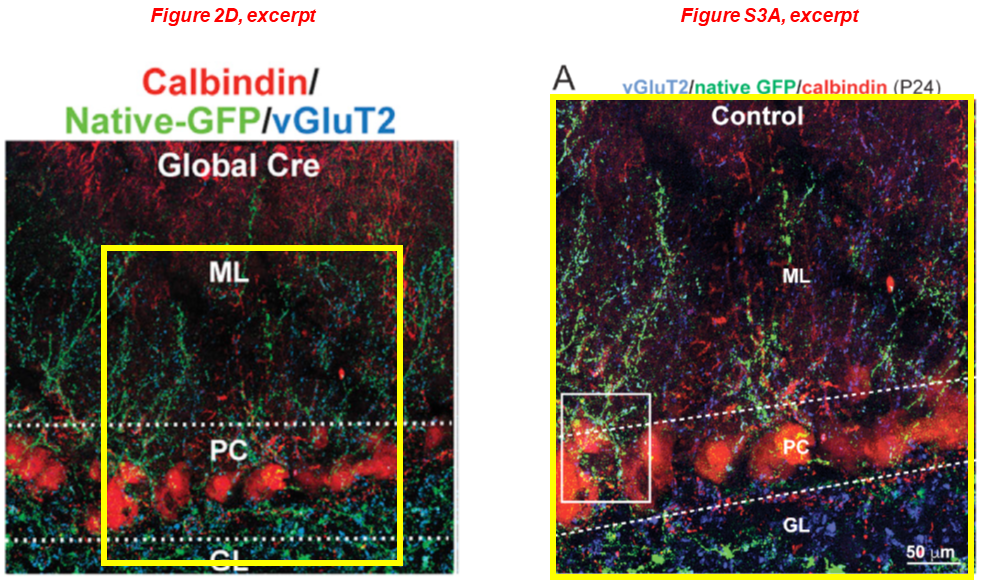
The Figure S3a was actually faker than originally thought.
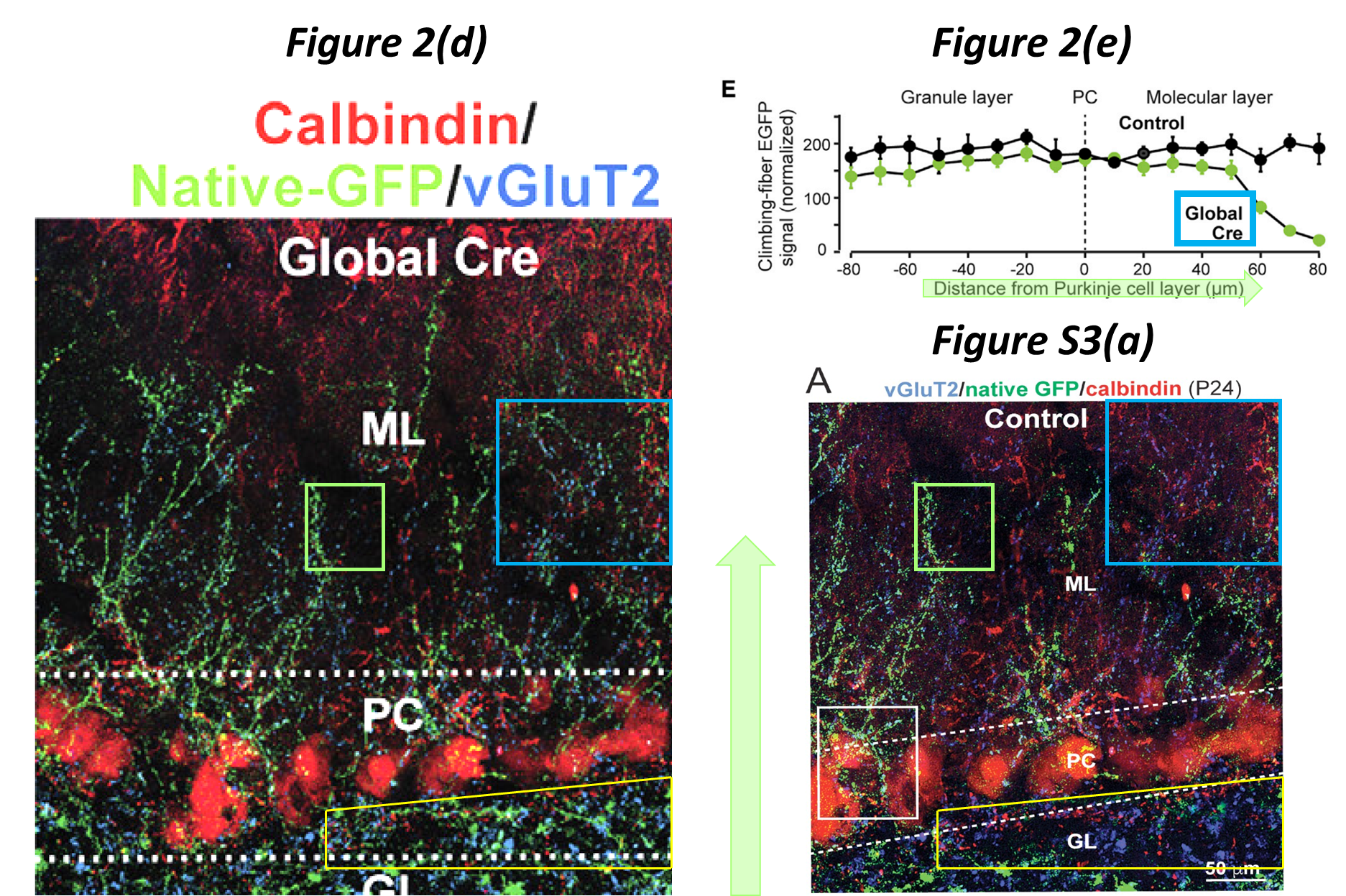
A zoom-in onto the blue rectangle (placed by Maarten) reveals duplications in the green but not in the blue or the red channel:
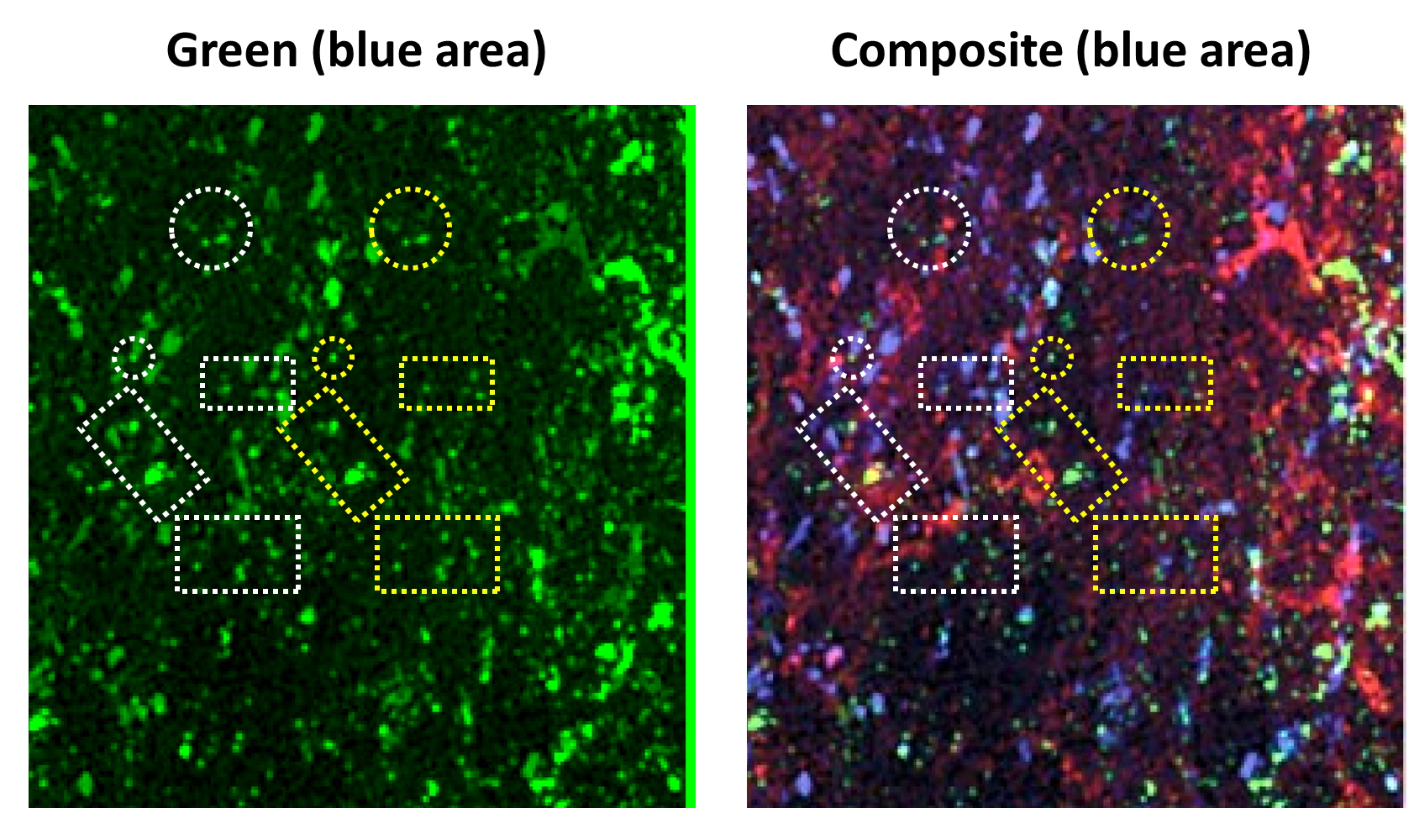
The first author and current UC Irvine group leader Lulu Chen previously announced on PubPeer that a correction (for Figure S3A alone) was negotiated with Cell Press. Maarten van Kampen voiced his concerns to the journal, and on 21 May 2024 he received a reply from Mariela Zirlinger, Editor-in-Chief of Neuron:
“Thanks for the note. I appreciate your bringing this issue to our attention. We’ve been reviewing the matter with the editorial team with the full cooperation of the author. FYI, we just published an author’s correction on this paper: https://www.cell.com/neuron/fulltext/S0896-6273(24)00361-1.
This Correction was published already on 16 May 2024:
“In our published paper, a panel from Figure 2D was inadvertently copy-pasted into Figure S3A instead of the correct panel. We recently identified this error in a newly enabled computational screen of our papers for image duplications. The correct image of Figure 3A is included here. We apologize for the error.”
Maarten’s reaction on PubPeer was:
“the duplication was, in fact, not a duplication. Many green ‘climbing fiber’ features are missing in Fig. S3(a). Additionally cloned elements appeared. […]
The authors even dare to write here that “a panel … was inadvertently copy-pasted”. This is most certainly not true: the panel was not copy-pasted, it was ‘adjusted’ and (inadvertently) re-used to represent a different group.”
And then of course there are also issues of clear image manipulation in Figure S4b which the correction simply ignored:
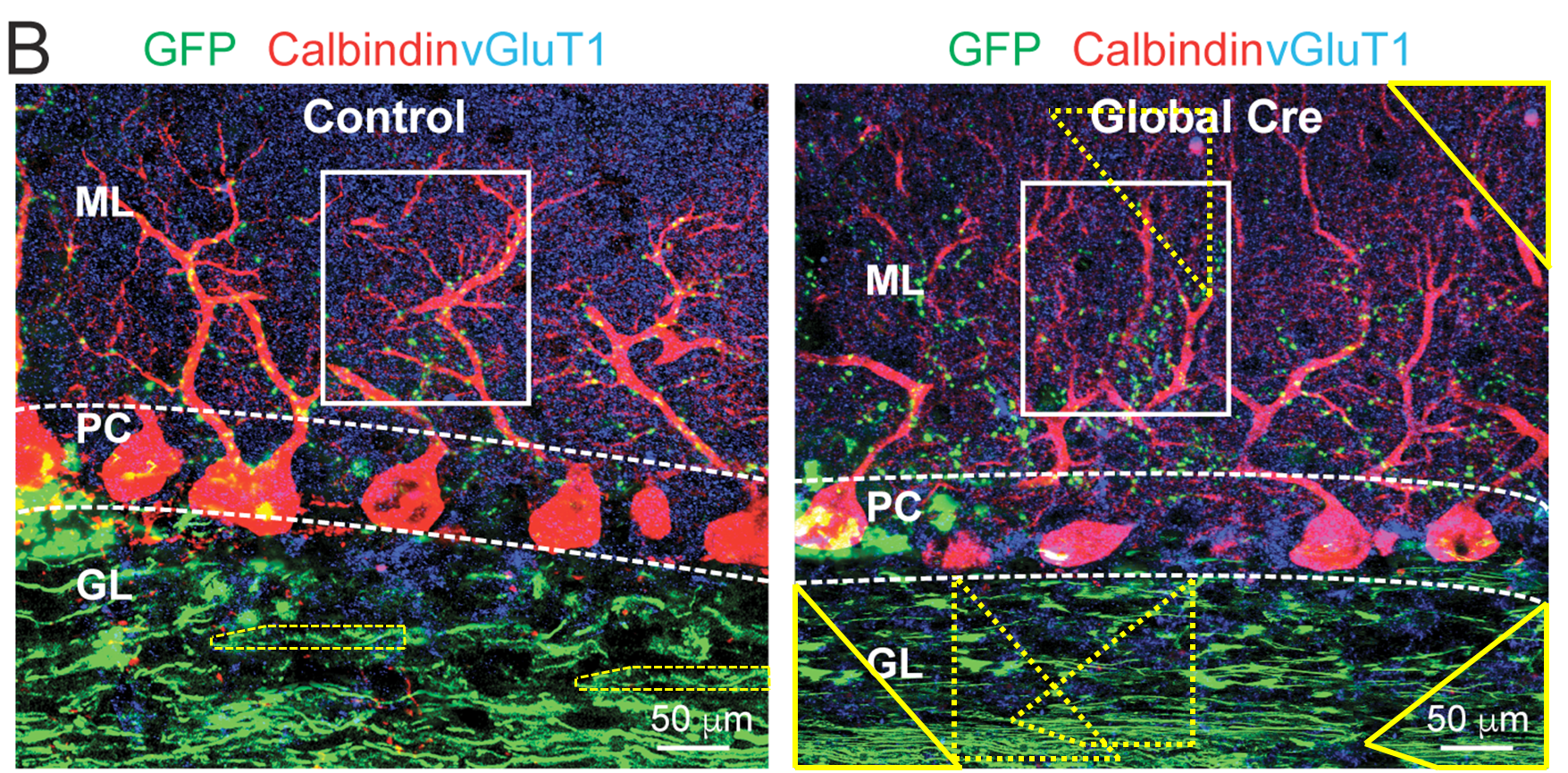
It can be that the original ‘Global Cre’ image was rotated. And that when aligning the tissue layers horizontal it was not possible to cut out a rectangular region of the same size as its ‘Control’ counterpart. This then would have left blank triangular regions at the corners of the image. It can be that an author or editor decided to fill in these blank regions by cloning other parts of the image”
The case is however closed now for Cell Press. In fact, the only reason they even issued that correction is because the authors asked for it. Cell Press has a policy of never retracting anything even upon institutional requests, unless the all authors beg for it.
Fousteri affair: Dutch integrity thwarted by academic indecency
Two and a half years after Maria Fousteri was found guilty of scientific misconduct by her former employer, the Leiden University Medical Center (LUMC), exactly nothing at all happened. ERC and Molecular Cell ignored LUMC letters from June 2016, while Fouster’s British co-authors interfered to save own papers. Of 4 scheduled retractions, none took place.
Südhof would not be Südhof if he didn’t use the opportunity to bully his critics. He posted on PubPeer:
“We feel that there is no need for further explanations on PubPeer in response to these repetitive accusations by ‘Orchestus quercus’ and his assistants (self-identified as Dr. Maarten van Kampen), except to point out that an independent imaging expert, Dr. Matthew Schrag, already described earlier the issues that can occur with digital reproductions. All of the PubPeer accusations against our lab and the mistakes we made and didn’t make are accounted for on our website: https://med.stanford.edu/sudhoflab/integrity—pubpeer.html.”
Truth is, Matthew Schrag suggested, long before the full extent of data manipulations in that paper was established by the evil Maarten van Kampen, that “these types of changes were introduced by journals or publishers (rather than the authors) to bring the figures into the cosmetic palette of the outlet.” I look into such suspect cases and for me this claim is rather unsupported (read in May 2024 Shorts), Certainly the manipulations in this paper were performed by people with access to unpublished raw data.
Yet, this dishonest Nobelist again publicly accused Cell Press of forging his data. And the publisher went on all four, licked his hand, and issued that dishonest correction.
Retraction Watchdogging
Lost confidence
The prestigious German University of Tübingen, their Medical School, and in particular the Department of Neurosurgery thought they have a cunning scheme running – their alumnus neurosurgeon Reza Akhavan-Sigari has been publishing masses of ridiculously fraudulent papermill fraud on all posisble fields of science years after he left but he keeps using the invalid Tübingen affiliation. Read here:
Gardening goats and external papermills in Tübingen
One shooting and one falling star of University Clinic Tübingen. Meet the research ethics champion Julia Skokowa and the eternally affiliated Renaissance Man Reza Akhavan-Sigari,
Instead of many papers, the Tübingen geniuses might get many retractions. This is Akhavan-Sigari’s second. Note that this papermill fabrication is about inorganic chemistry, an unusual topic for a neurosurgeon:
Mohamed J. Saadh, Hussam Elddin Nabieh Khasawneh , Geovanny Genaro Reivan Ortiz, Muhammad Ahsan, Dinesh Kumar Sain , Kareem Yusuf , Mika Sillanää , Amjad Iqbal , Reza Akhavan-Sigari Synthesis and characterization of ZrFe2O4@SiO2@Ade-Pd as a novel, recyclable, green, and versatile catalyst for Buchwald–Hartwig and Suzuki–Miyaura cross-coupling reactions Scientific Reports (2023) doi: 10.1038/s41598-023-37680-2
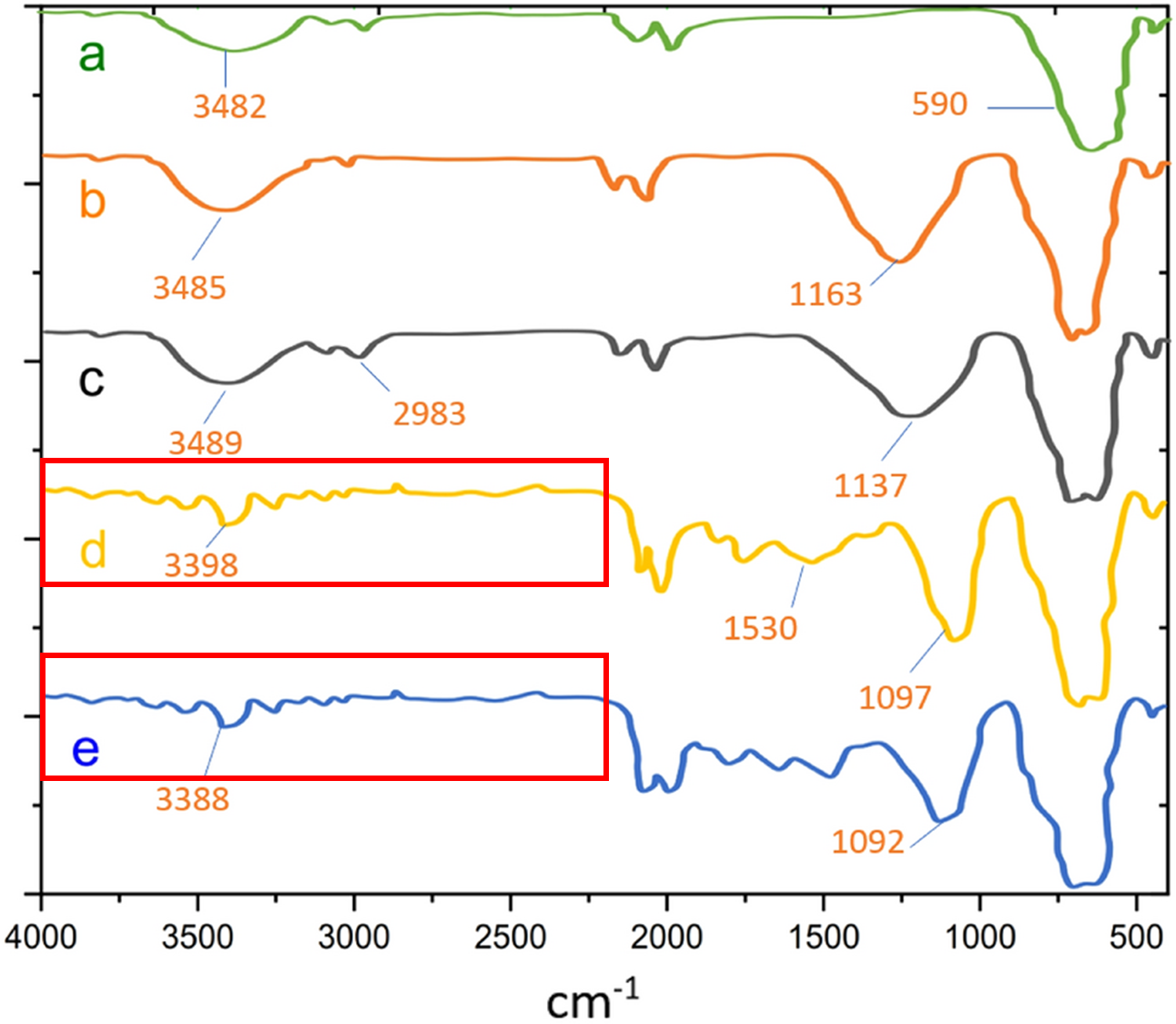
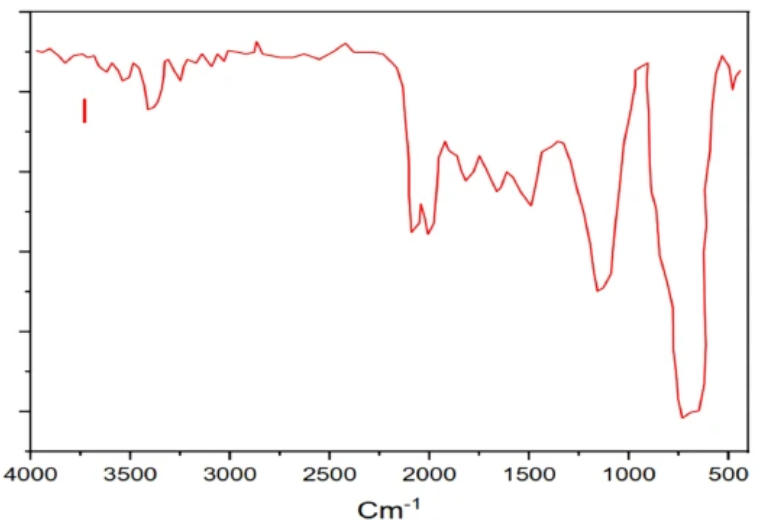
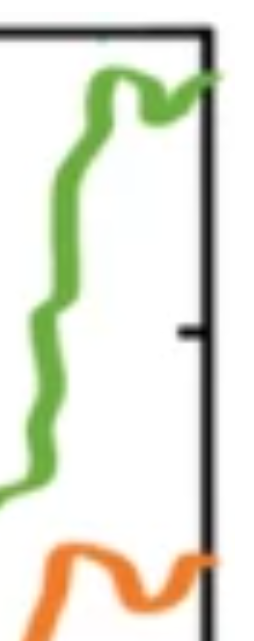
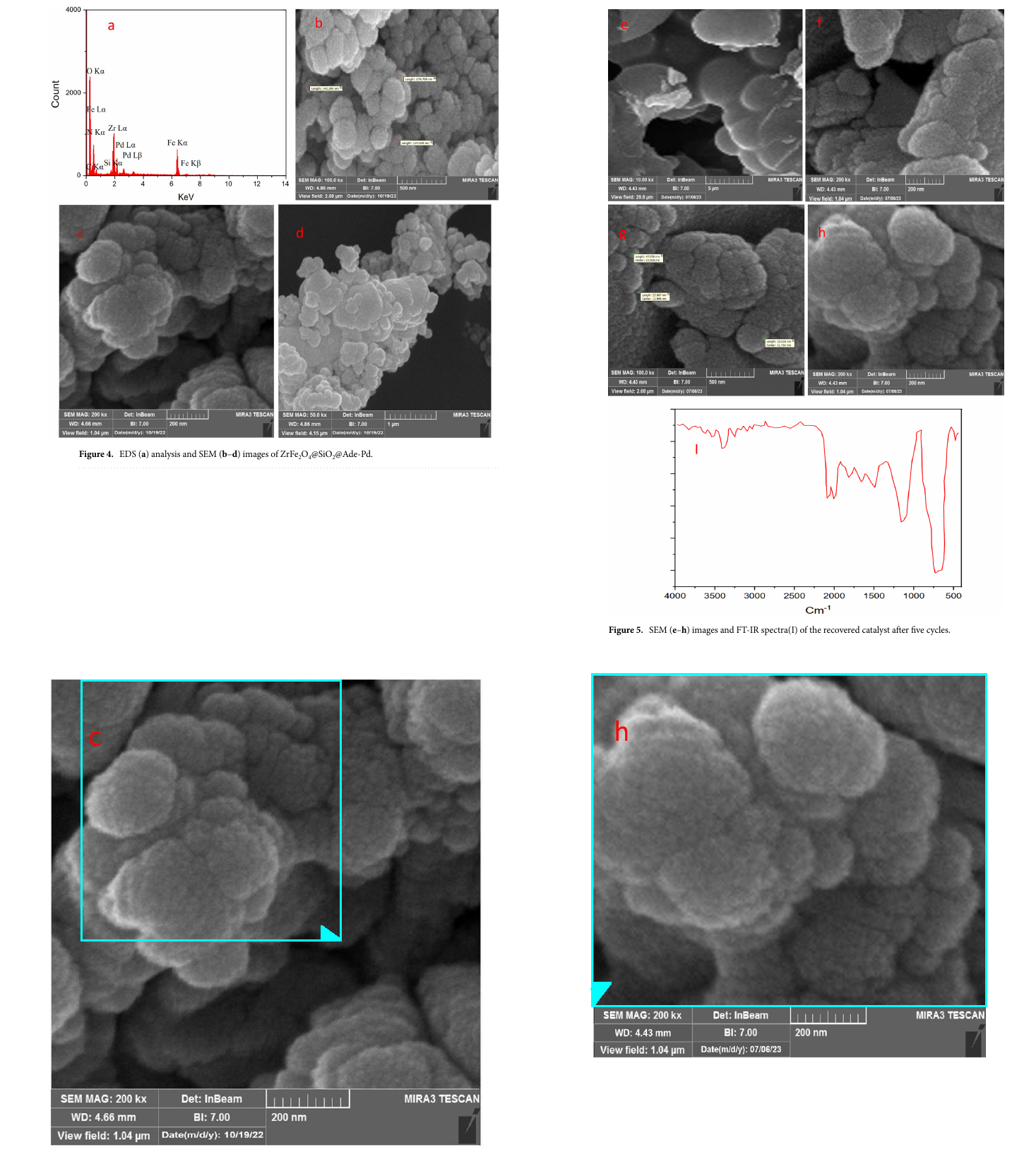
Obviously hand-drawn. Still, in September 2023, the journal issued a Correction to fix “an error in Figures 1 and 5.”. The corrected FTIR graph was just as fake and hand-drawn:

Daviesia articulata: “In Fig. 1 the overshooting part of the graphs was removed, now there is a gap instead. Additionally, as in the original version, the lines of some of the FT-IR spectra cross certain wavenumber values twice or more times with different intensities. This is physically impossible. The spectra also have varying linewidths.”
Then, Elisabeth Bik found even more, namely textual plagiarism and stolen images:
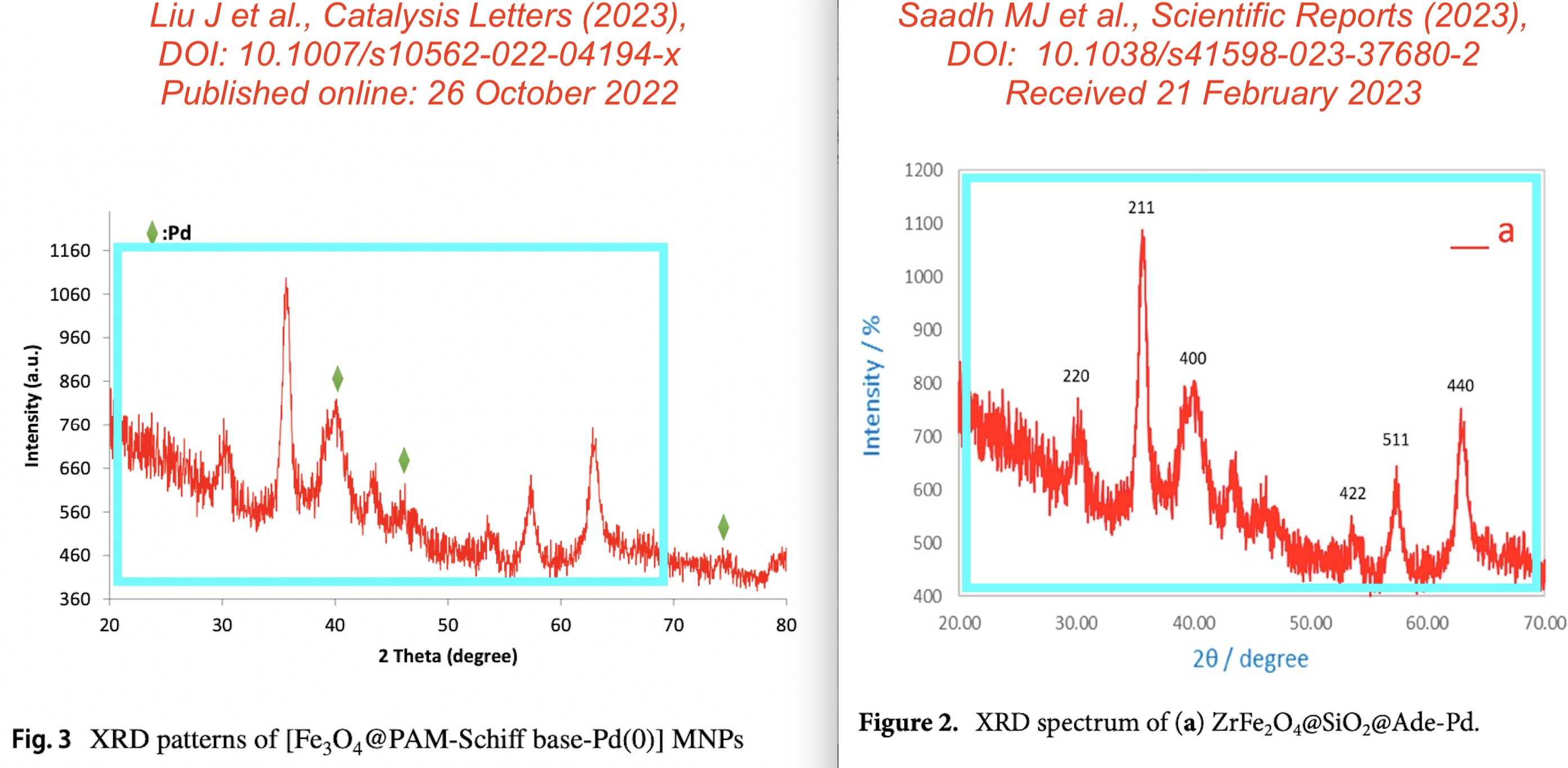
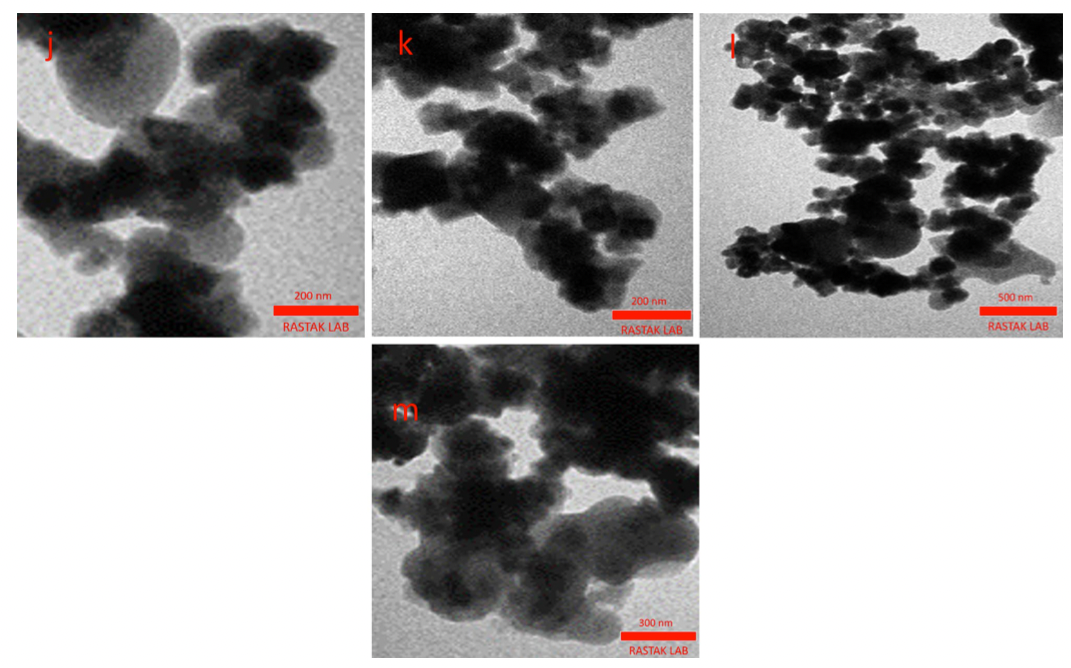
Also note the co-author Mika Sillanpää, a Finnish papermiller who was sacked in his home country for sexual harassment, bullying, research fraud and theft of institutional funds. Read here:
Hier kommt Herr Sonne
“Go and change the globe to a more positive future instead”
The Retraction was published on 21 May 2024:
“The Editors have retracted this article.
After publication, concerns about the FTIR data in Figure 1 and XRD spectrum in Figure 2 were raised to the Editors. The Editors requested full raw data from the Authors, but the Authors did not provide a response, and the published Author Correction1 also does not address the concerns satisfactorily. The Editors have therefore lost confidence in the reliability of the article’s findings and conclusions.
Geovanny Genaro Reivan Ortiz agrees with this retraction. The remaining authors did not respond to correspondence from the publisher about this retraction.”
Should be a lesson for editors not to correct fraudulent trash from known papermillers. Not really, they will never learn.
Unable to verify the accuracy of the originally listed authorship list
Yet another retraction for the King of Papermillers Rafael Luque, his right-hand man Awais Ahmad, and the russian papermiller Dmitry Bokov. Read about them here:
You will be paid US $500-800 for each paper
“Or The author can also put your name to the article to increase your academic popularity, such as adding your name to the second or third author.”
Here is the newly retracted paper, flagged on PubPeer by Alexander Magazinov. Ahmad was the editor of the MDPI Special Issue where this was published:
Indah Raya , Awais Ahmad , Ayad F. Alkaim , Dmitry Bokov , Enas R. Alwaily , Rafael Luque , Mabkhoot Alsaiari , Mohammed Jalalah Synthesis, Characterization and Photodegradation Studies of Copper Oxide–Graphene Nanocomposites Coatings (2021) doi: 10.3390/coatings11121452
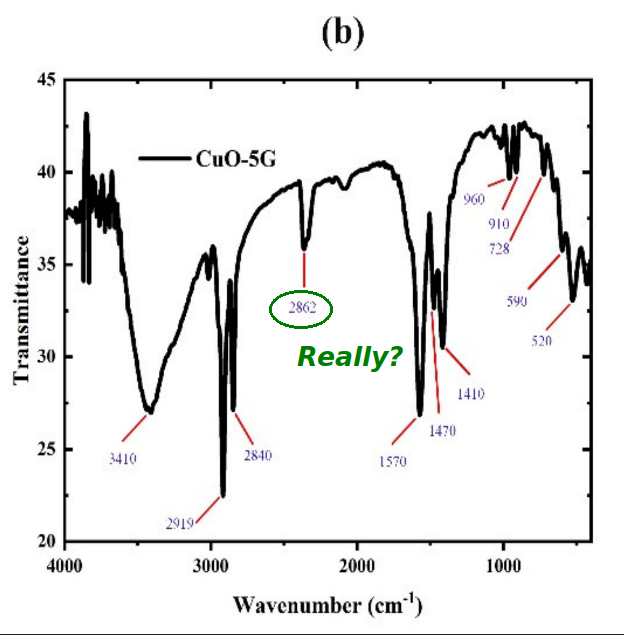
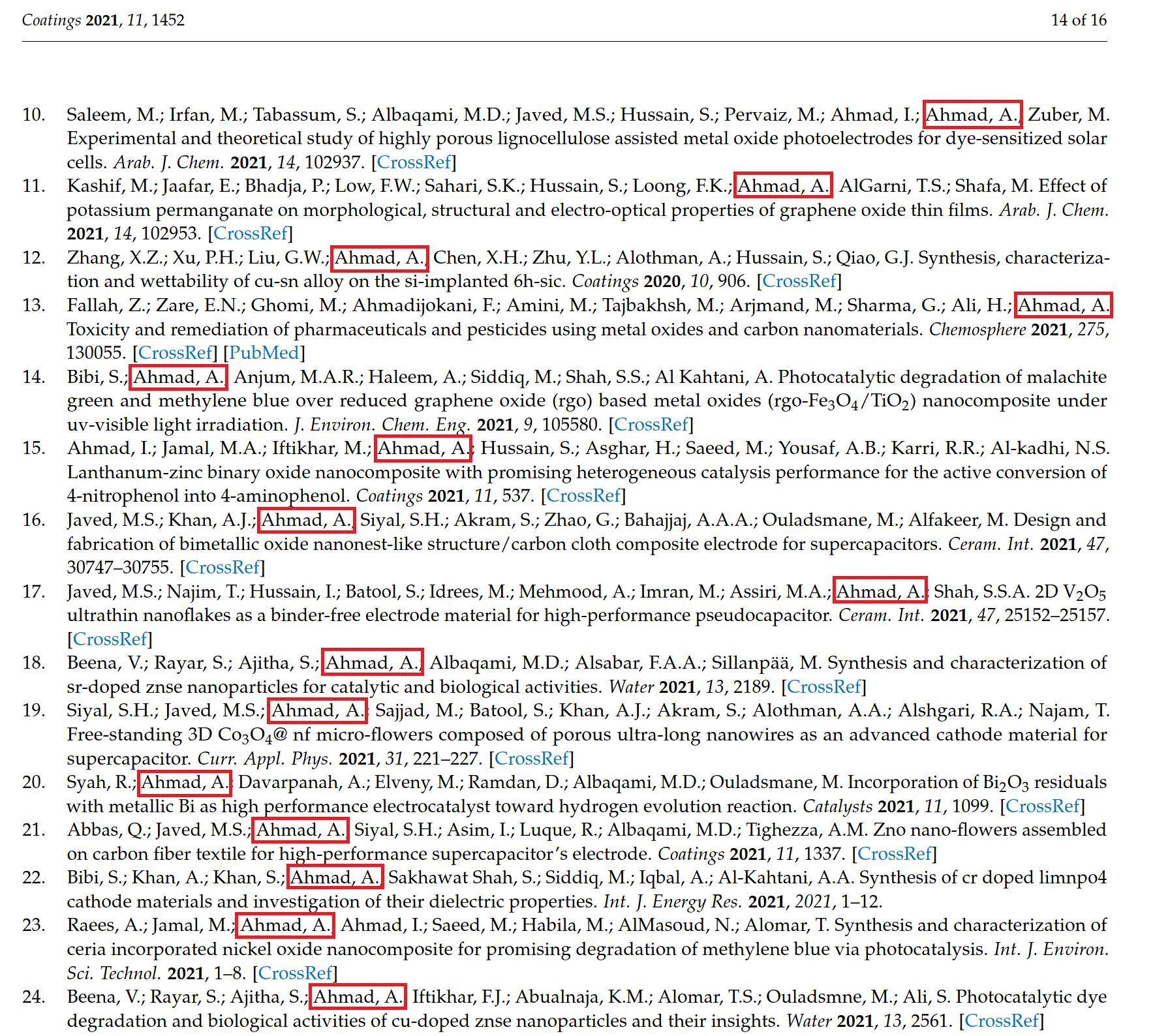
The Retraction was published on 21 May 2024:
“Following the publication, concerns were brought to the attention of the Editorial Office regarding issues related to the accuracy of the authorship list, the origin of the reported study, and the relevancy of the references in [1], as cited above.
Adhering to our procedure, an investigation was conducted by the Editorial Office and the Editorial Board. Following communications with the authorship group, the Editorial Office was unable to verify the accuracy of the originally listed authorship list, nor were the authors able to provide raw material to confirm the origins of this study. The relevant institutions were also contacted but failed to respond to these concerns. Furthermore, the Editorial Board judged that a significant portion of the literature cited was not sufficiently relevant to this publication and thus does not comply with MDPI’s Citation Policies (https://www.mdpi.com/ethics#_bookmark20, accessed on 7 May 2024). As a result, the Editorial Board has lost confidence in the integrity of the findings and decided to retract this publication […]
This retraction was approved by the Editor-in-Chief of the Coatings journal.
Rafael Luque agreed to this retraction, while all the other authors did not agree with this retraction.”
“Editorial Office was unable to verify the accuracy of the originally listed authorship list” means authorships were sold and then added when the accepted paper was prepared for publication.
A number of articles, including this one
Springer is apparently retracting an entire Special Issue for papermilling, and its guest editor, an associate professor at the University of Uppsala in Sweden, is to blame. You can read about Zhihan Lv (or Zhihan Lyu) in May 2024 Shorts.
A string of papers were retracted in April-May 2024 in the journal Neural Computing and Applications, all retraction notices mentioned:
“An investigation by the publisher found a number of articles, including this one, with a number of concerns, including but not limited to compromised editorial handling and peer review process, inappropriate or irrelevant references or not being in scope of the journal or guest-edited issue.”
Now even Lv’s Editorial was retracted:
Zhihan Lv , Jim Jingyan Wang , Xiaonan Luo Editorial: neural computing in next-generation virtual reality technology Neural Computing and Applications (2018) doi: 10.1007/s00521-017-3261-8
The Retraction notice from 21 May 2024 stated:
“The Editor-in-Chief and the publisher have retracted this article. The article was submitted to be part of a guest-edited issue. An investigation by the publisher found a number of articles, including this one, with a number of concerns, including but not limited to compromised editorial handling and peer review process, inappropriate or irrelevant references or not being in scope of the journal or guest-edited issue. Based on the investigation’s findings the Editor-in-Chief therefore no longer has confidence in the results and conclusions of this article.
Zhihan Lv did not explicitly state whether or not they agree to this retraction. Xiaonan Luo did not respond to correspondence from the publisher about this retraction. The publisher was not able to obtain a current contact email for Jim Jingyan Wang.”
Swedish rector Anders Hagfeldt pronounced innocent of papermilling
“The board’s conclusion is therefore that the deviations regarding figure 2b and 2c in article 1 constitute serious deviations from good research practice”
Lv is currently on leave of absense and is expected to return to Uppsala in July 2024. On 17 May 2024, Frida Ringholm, the secretary of the The Board for Investigation of Deviations from Good Research Practice at Uppsala University, informed me about Lv:
“The case you are referring to, UFV 2023/2045, is currently under investigation.
It is correct that Zhihan Lyu has asked for a leave of absence until the end of June.
I have no further information.”
Meh, I hoped Uppsala suspended him, but Lv went to China on his own accord to work on his papermill business.
Without appropriate attribution
A retraction for the power couple at the University of Saarland in Germany, the orthopaedic surgeons Henning Madry and his wife Magali Cucchiarini-Madry who were previously encouraged to continue collaborating with papermillers by their university and the German national research integrity Ombudsman. Read here:
German Authorities on Papermills and Whistleblowing
“I am not familiar with Iranian papermills!” – Prof Dr med Henning Madry, Saarland University.
This is the now retracted paper and its stolen figures, originally flagged by Smut Clyde, and declared by University of Saarland to be free of all suspicions of research misconduct:
Mohamed Mediouni , Daniel R. Schlatterer , Henning Madry , Magali Cucchiarini , Balwant Rai A review of translational medicine. The future paradigm: how can we connect the orthopedic dots better? Current Medical Research and Opinion (2018) doi: 10.1080/03007995.2017.1385450
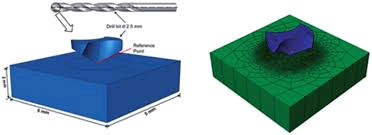

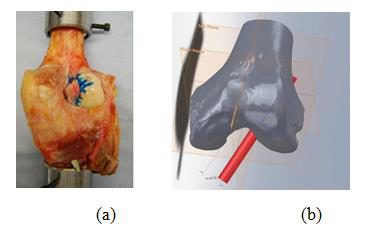

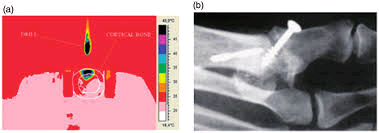
On top, Alexander Magazinov found several instances of textual plagiarism.
Madrys’ coauthor is a certain Balwant Rai – a scamference organiser, “Space Dentist“, and a “broad-spectrum fabulist“. Read about him here:
Nobelist Harald zur Hausen and the Scamferences
Smut Clyde tells you about some abysmally bad scamferences and the kind of scholars frequenting them, and I explain why Nobel Prize winner Harald zur Hausen is one of them.
Also, as Smut Clyde noted:
“Second author Daniel Schlatterer appears as a Director of “JBR University”. The 5th author, “Prof. (Dr.) Balwant Rai” – “Program Director and Associate Professor of Aeronautic Dentistry at Kepler Space Institute” – is President of that nebulous organisation. https://web.archive.org/web/20190505000519/https://www.jbruniversity.com/about-us/“
In December 2022, Alexander Magazinov and I notified the journal’s editors and the research integrity officer at Taylor & Francis. The journal’s Executive Editor Mithi Ahmed-Richards announced to “flag this as an urgent priority” and informed me that the previous Editor-in-Chief Dimitri Mikhailidis who accepted that paper had stepped down. In January 2023, Taylor & Francis’ Senior Editor Kelly Soldavin informed me:
“we gather further information on the actions taken at that time, as well as any current activities in place, related to this particular author and article.”
One and a half year later the paper was finally retracted. I can’t help but think that University of Saarland has been fighting tooth and nail to prevent this shame to their professors Madry. The retraction notice was issued by the publisher on 21 May 2024:
“Following publication, concerns were raised about by a third a party about the integrity and sources of the images presented in the article. When approached for an explanation, the authors confirmed that their images had been reused from the following publications, without appropriate attribution:
- Lughmani et al, Drilling in cortical bone: a finite element model and experimental investigations. 2015 https://www.sciencedirect.com/science/article/abs/pii/S1751616114003427
- Moon et al, Effect of Anteromedial Portal Entrance Drilling Angle during Anterior Cruciate Ligament Reconstruction: A Three-Dimensional Computer Simulation. 2014 https://www.eymj.org/DOIx.php?id=10.3349/ymj.2014.55.6.1584
- Bertllo et al, Drilling of Bone: Practicality, Limitations and Complications Associated with Surgical Drill-Bits. 2011 https://www.intechopen.com/chapters/19652
- Cartiaux et al, Improved Accuracy with 3D Planning and Patient-Specific Instruments During Simulated Pelvic Bone Tumor Surgery. 2013 https://link.springer.com/article/10.1007/s10439-013-0890-7
Upon further review, text overlap with the following published article was also identified:
- Benassi, Maria Serena et al., The role of imaging for translational research in bone tumors, European Journal of Radiology, Volume 82, Issue 12, 2115 – 2123
This overlap was identified under the section “Precise tumor localization: critical to patient outcomes – can it be improved?”
We have been informed in our decision-making by our editorial policies and the COPE guidelines.
The retracted article will remain online to maintain the scholarly record, but it will be digitally watermarked on each page as ‘Retracted’.”
I thank all my donors for supporting my journalism. You can be one of them!
Make a one-time donation:
I thank all my donors for supporting my journalism. You can be one of them!
Make a monthly donation:
Choose an amount
Or enter a custom amount
Your contribution is appreciated.
Your contribution is appreciated.
DonateDonate monthly










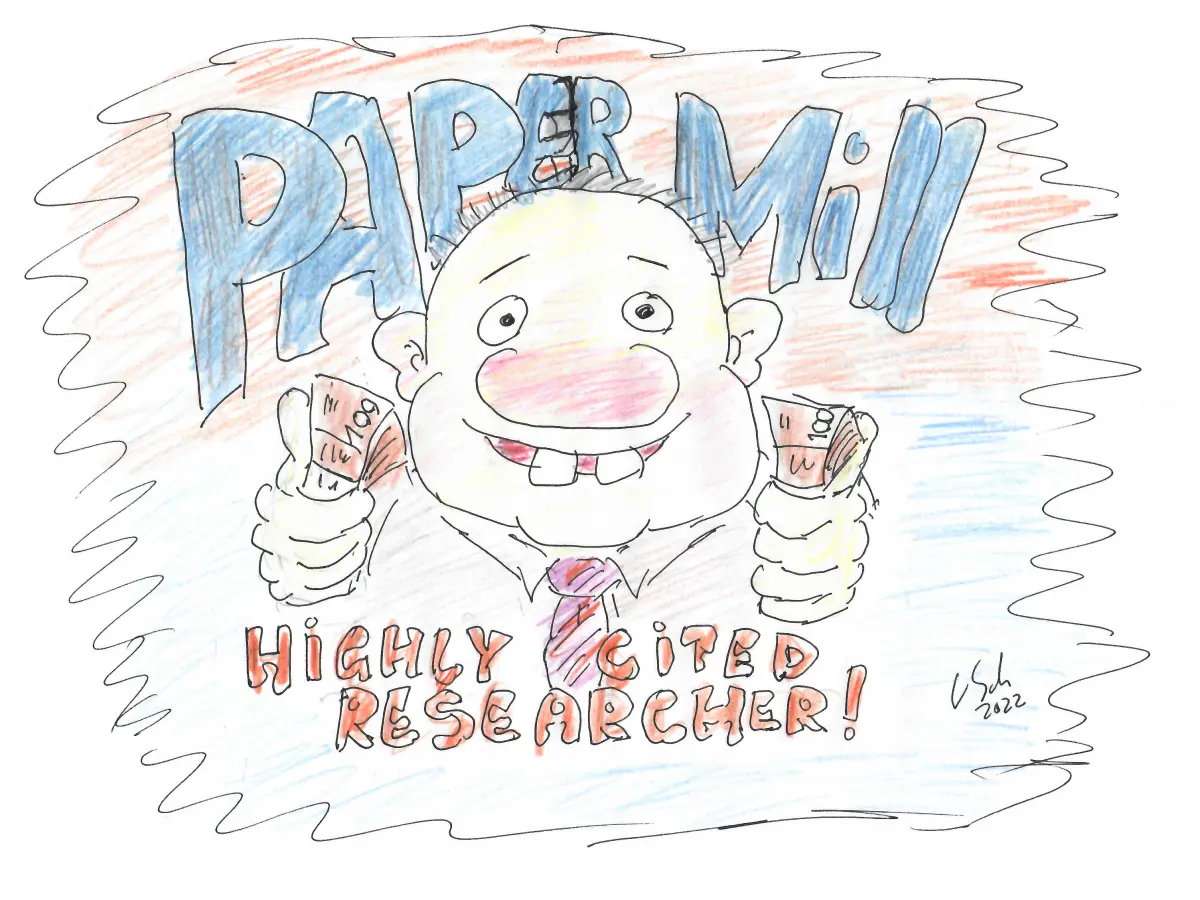




I am sorry to say this, but you are not correct when it comes to Mika Sillanpää. He did NOT get a retraction! Mika Sillanää however did get a retraction! https://www.nature.com/articles/s41598-024-62395-3 :p
LikeLike
In any case, I wish to congratulate the University of Aarhus. So much for them to be proud of.
LikeLike
Ah yes, the university of Aarhus! The place to be for papermillers! We should send them an official certificate, having both Sillanpää (or Sillanää) and Christian Sonne! They are doing a great job at Aarhus, recruiting all that talent! Now they only need Christophe Len (or his son Thomas, bigger future ahead) and/or Rafael Luque and Aarhus is truly king of the world!
LikeLike
Actually, Mika is now listing as affiliation “Functional Materials Group, Gulf University for Science and Technology, 32093, Mubarak Al-Abdullah, Kuwait”
See here:
https://link.springer.com/article/10.1007/s42452-024-05857-7
LikeLike
M. Sillanpää collects affiliations like regular people change socks! If you check his Clarivate profile, you will find an insane list of institutes! Makes no sense whatsoever. I wonder if he gets paid by these institutes to publish with their affiliations….
LikeLike
Marteen’s comments and pinpointing how the images are manipulated is so clear and impressive, at this point Sudhof is either a complete idiot or an absolute fraud…
LikeLike
I’d say just an average Nobelist.
Seriously though, I am sure there are some good scientists among Nobel Prize laureates. Some may even be honest and decent human beings.
LikeLike
I dont think Sudhof is an idiot or a fraud himself, rather, he is acting this way because he is in the denial phase of this situation. In denial that so many people that worked for him would make mistakes or commit fraud, and this causes him to be somewhat, if not mostly, intellectually dishonest about the situation. The reason I say somewhat is because he did retract one paper (in his favor), yet he is in denial about the Lulu Chen paper (against). I read this interview of him:
https://www.ncbi.nlm.nih.gov/pmc/articles/PMC3859417/
Here, he seems pretty rational and made decisions that turned out to be great ones for his career. Therefore, I think he is mostly a victim of his own success: again, what I call the Croce/Sudhof effect: fraud is more likely to occur in labs of famous people because the temptation to commit fraud is greater. I think we have to give him credit for being transparent about the situation on his website, even if he is denying the charges when he should not be.
LikeLike
I’m going to rename the Croce/Sudhof effect to now be the Semenza/Sudhof effect as I am now slightly less likely to be sued.
LikeLiked by 1 person
Maybe a case of ‘The Emperor’s New Clothes’?
A tale of an emperor who is duped by two swindlers who claim to make him a magnificent suit of clothes that are invisible to those who are stupid or unfit for their positions. The emperor parades around in these “clothes” and it takes a child’s innocent honesty to reveal that he is, in fact, wearing nothing at all. A powerful commentary on vanity, pride, and the fear of speaking the truth.
LikeLike
In the end all we can do is gamble… We can’t know. Are others committing fraud without him knowing? Is he in on it? We knows? Only of he comes clean and really spills the truth we will know.
LikeLike